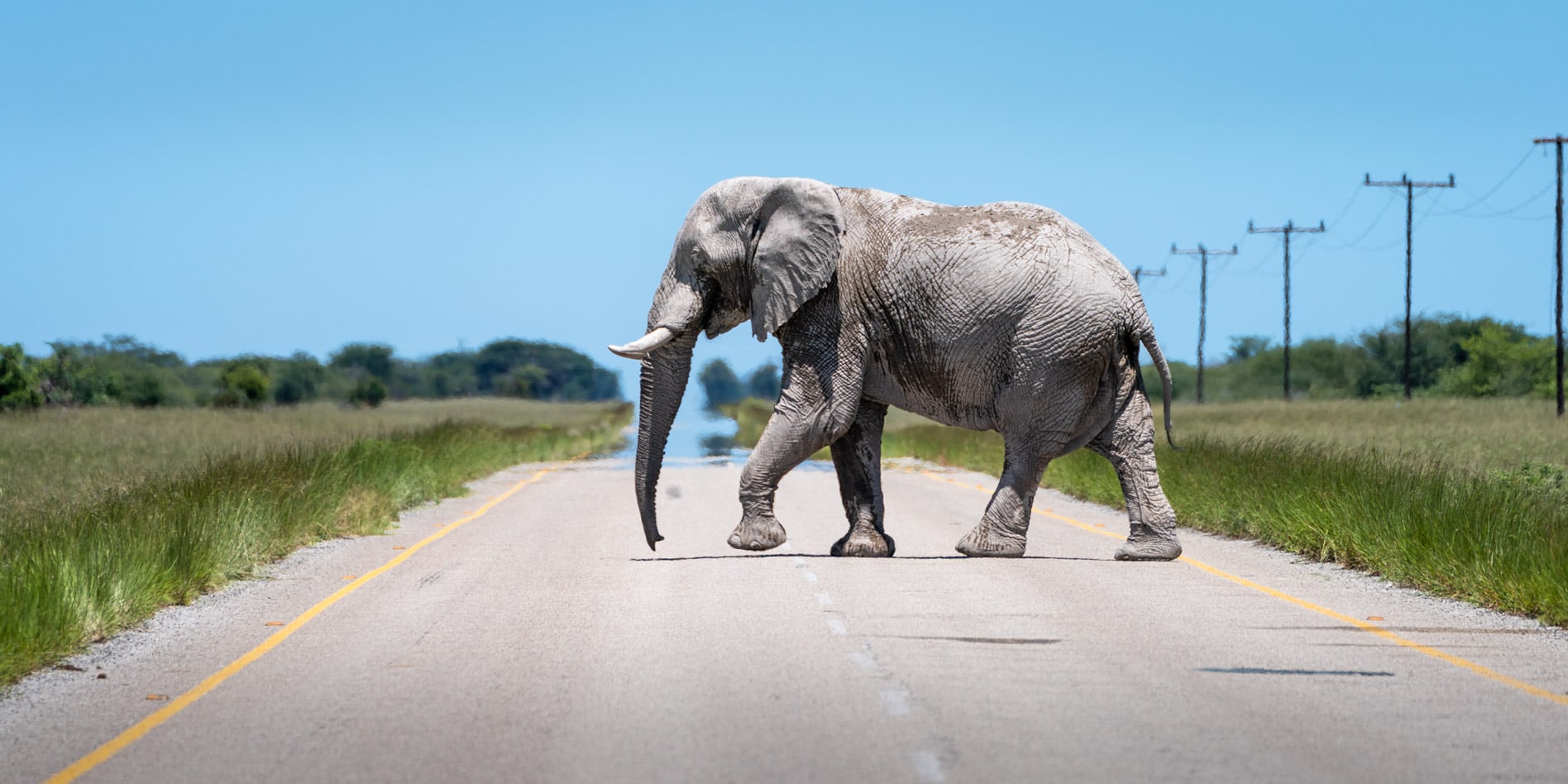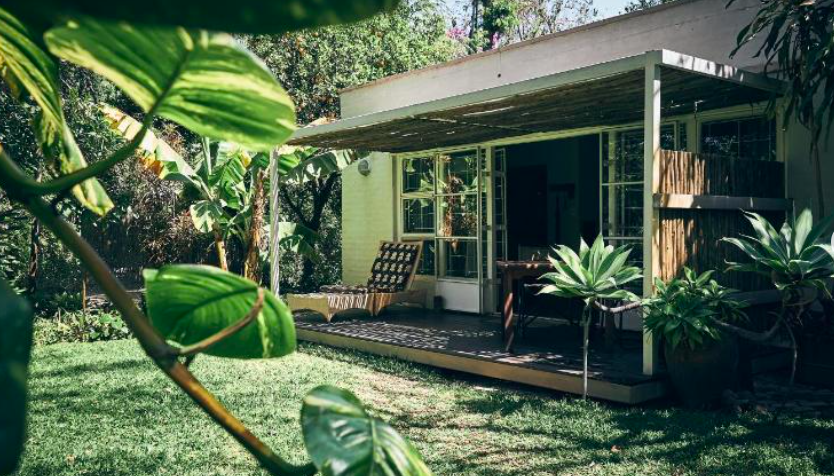Should you worry about a mosquito that lands on you with its bum in the air?
What happens at a Botswana VET Fence?
Do I need a 4×4 to overland Botswana?
And did you know that what you do or don’t do with your hands can make you seem rude?
You’ll find the answers to these and many more in these useful overlanding Botswana tips.
Tips that will help you enjoy your adventure rather than stressing about the small stuff — which can turn into big, annoying stuff if you aren’t prepared.
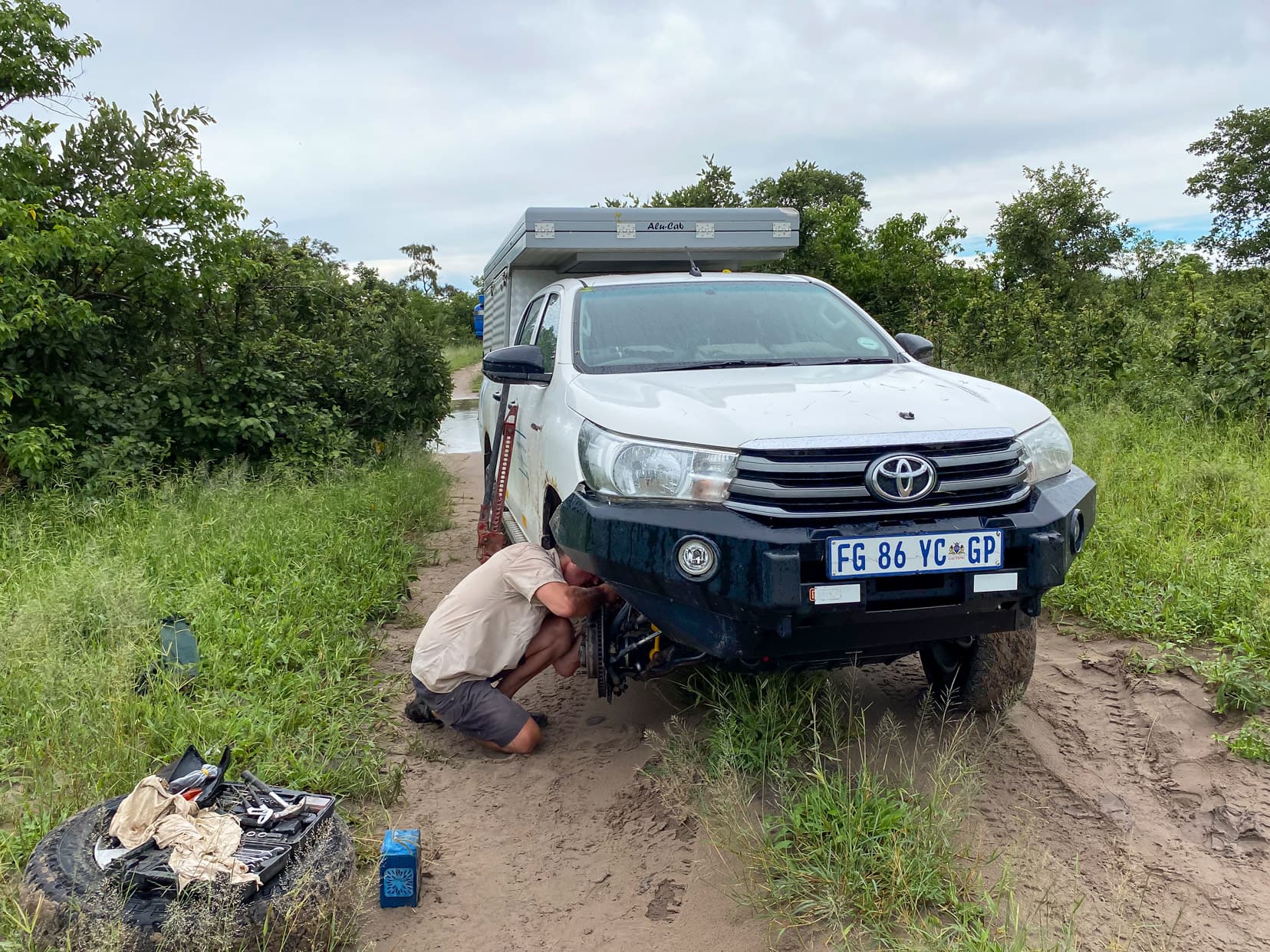
🐘 What’s In This 50 Helpful Overlanding Botswana Tips Article
Planning a Trip to Botswana?
- 🚗 Hiring a car? We recommend getting a quote from DiscoverCars
- 🚐 Hiring a campervan? We recommend Motorhome Republic
- ⛑ Arranged your travel insurance? Compare quotes from World Nomads & Safetywing
- 🪪 Order your International Driver’s Licence online here
- 🏩 Booked your accommodation? We use Booking.com to find the best deals
- 🐾 Is someone pet-sitting for you? 🐾 We use and love TrustedHousesitters
- (Get 25% off at checkout for new memberships with our discount code: LIFEJOURNEY25)
You’ll likely have enough surprises while overlanding Botswana — we had plenty when we travelled on our camping safari throughout Botswana for just under three months.
Like trumpeting elephants suddenly appearing behind bushes, deep sand intent on sucking your vehicle into the core of the earth, intense thunderstorms and tyres deciding to explode at the most inconvenient times.

These overlanding travel tips for Botswana will smooth out the bumps.
Unfortunately, we can’t do the same with some of Botswana’s roads. Potholes and corrugations are part of overland travel.
Most people, like us, choose to overland Botswana by 4×4, but whatever transport you choose to overland, this guide will help you in some way.
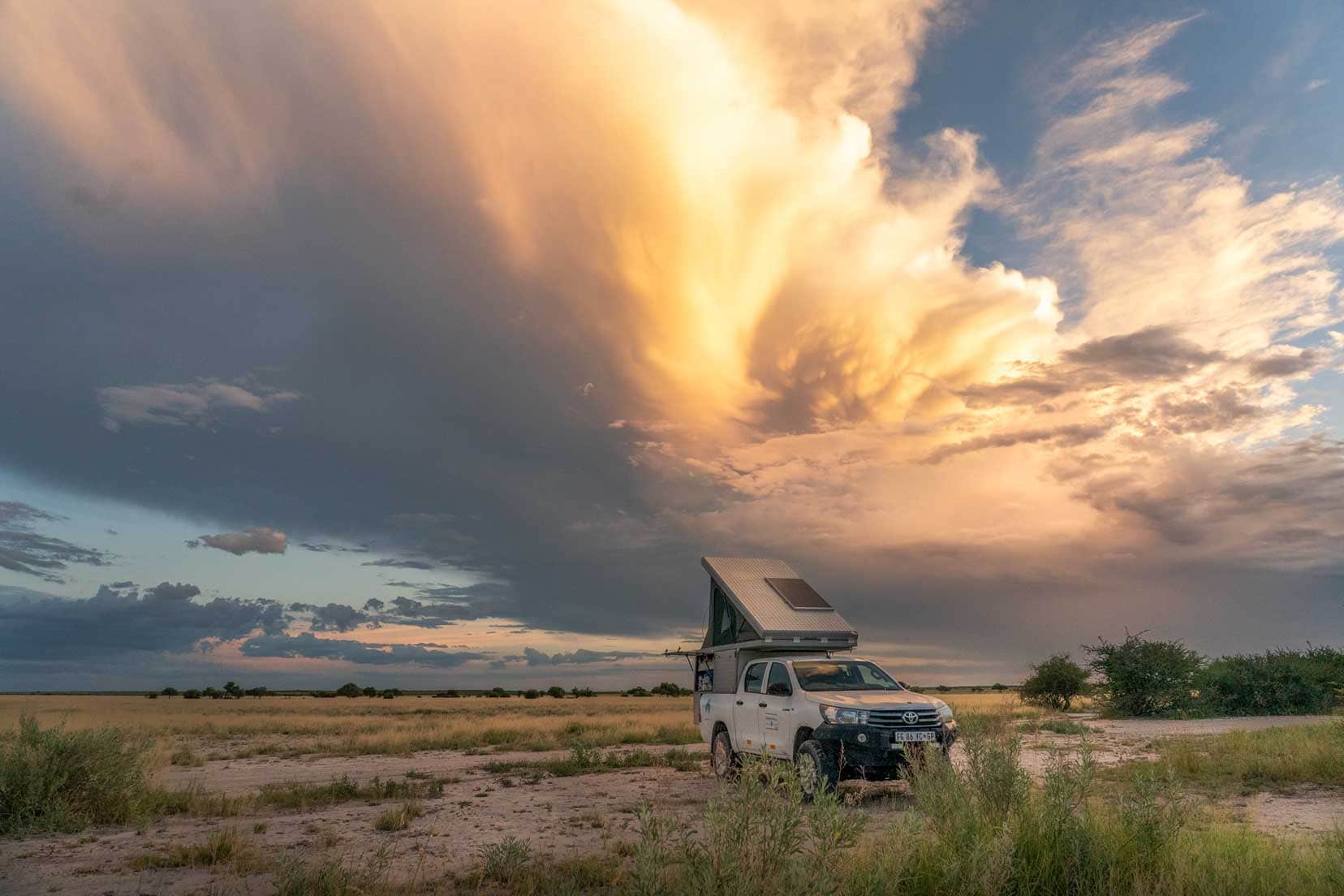
We met people overlanding Botswana by bicycle, motorbike, 4×2 vehicles and those on organised overland tours.
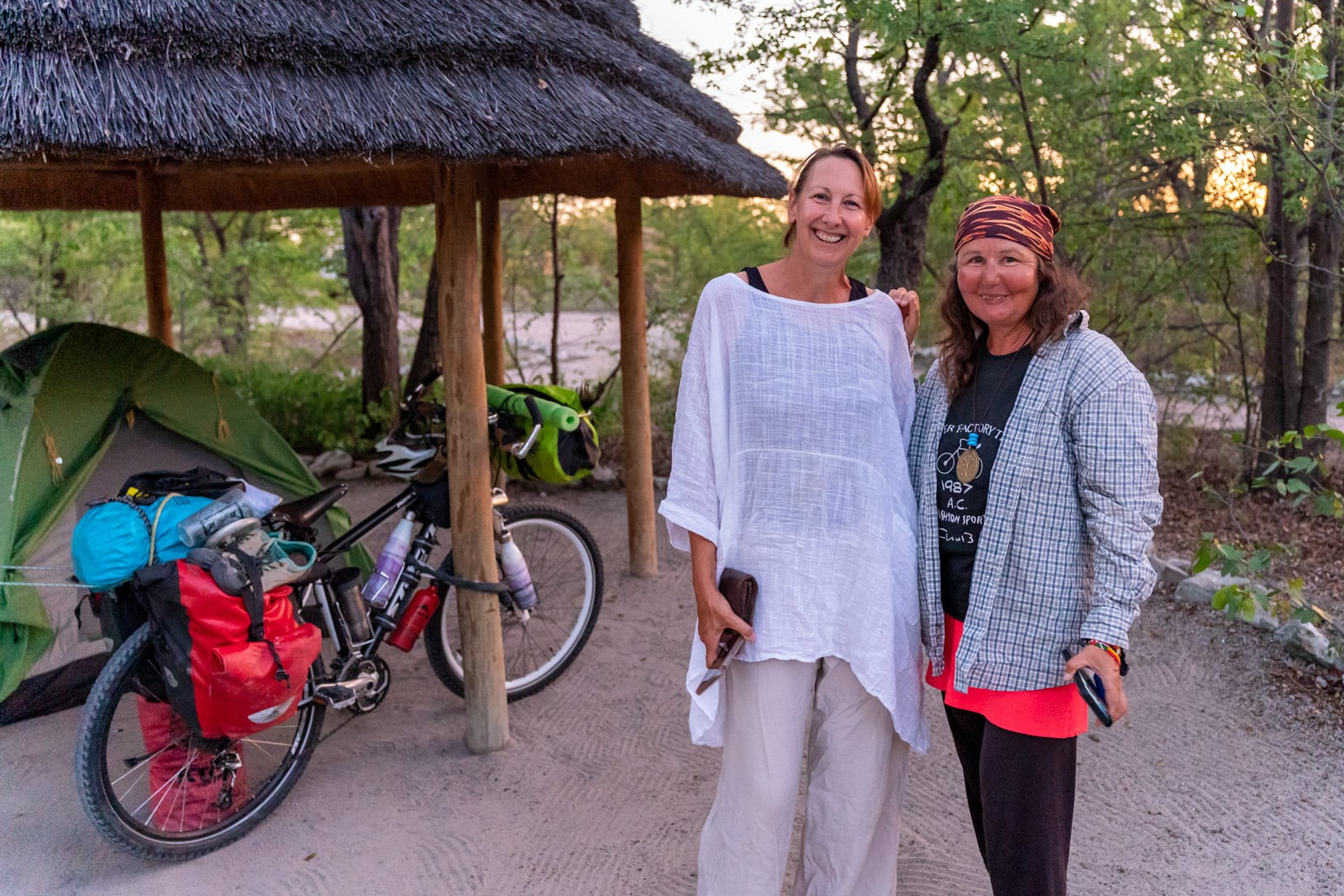
Meeting Anna, cycling her way through Botswana from South Africa to Rwanda, was a reminder of the incredible stories of women travellers in Africa.
Each journey is a tale of courage, resilience, and the sheer joy of exploring the unknown. Inspired by these adventures, we’ve shared stories of inspirational women travellers who’ve made Africa their canvas for exploration.
To make it easy for you to jump to the parts of this article that are of particular interest to you, we’ve grouped these tips into sections.
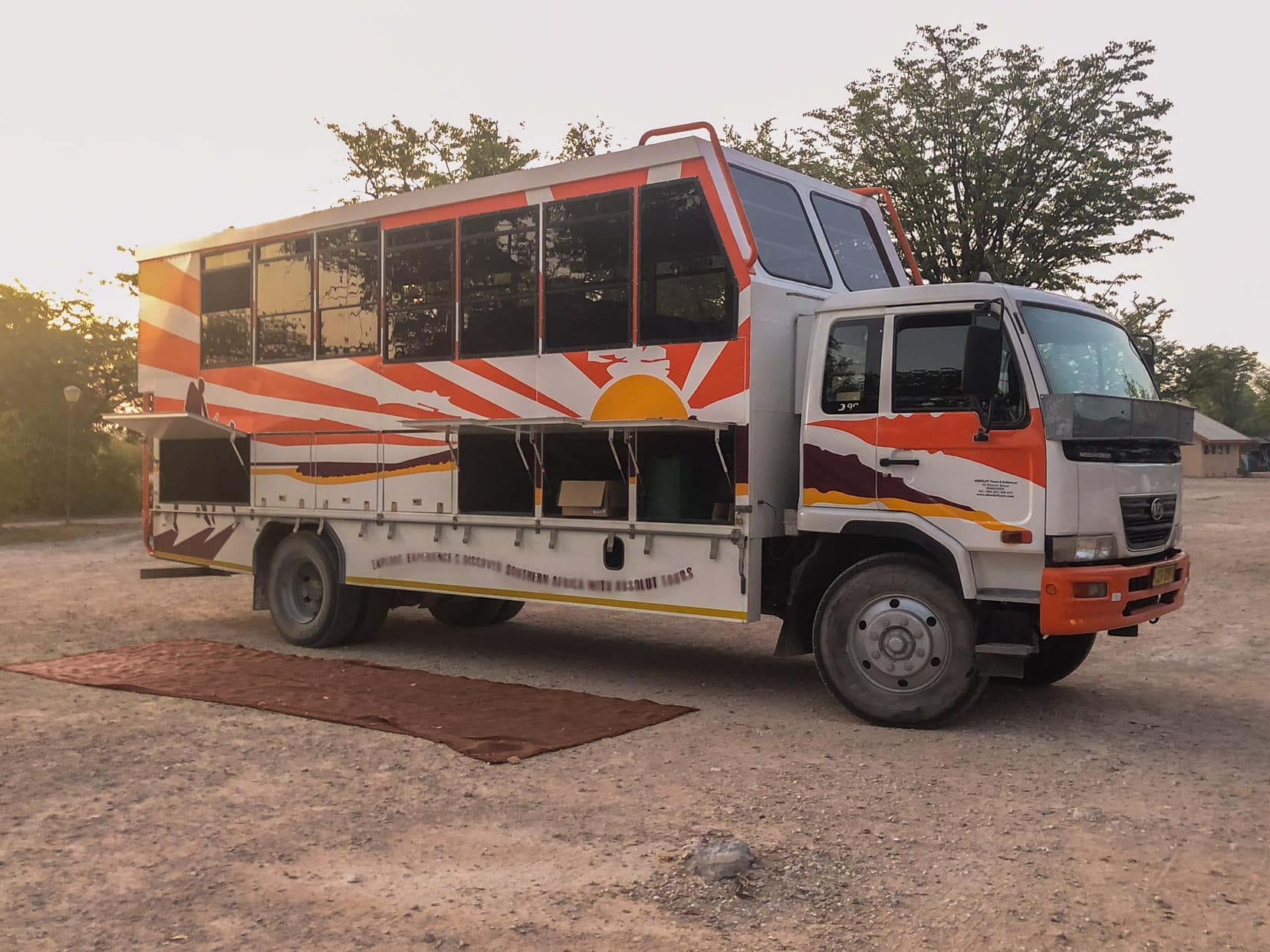
General Overlanding Botswana Tips
Overlanding in Botswana is an opportunity to connect with nature, experience wildlife in its natural habitat, and create unforgettable memories.
By following these general travel tips and being prepared for your visit, you’ll be well-equipped for an extraordinary adventure in the heart of Africa.
1. The Best Botswana National Parks to Visit
There are heaps of National Parks in Botswana. In fact, almost a fifth of the country is made up of National Parks and Game Reserves, and we visited almost all of them on our Botswana itinerary.
Most of these parks are easier to visit in the dry season (in the winter months), but we experienced most of them in the rainy season.
But whatever time you choose to visit, these are worth putting on your itinerary.
- Chobe National Park ( We stayed at Savuti Rest Camp and Ihaha Rest Camp)
- Moremi Game Reserve (Camping in the Okavango Delta, the UNESCO-listed jewel of Botswana, is a highlight of any overlanding visit to Botswana)
- Kwai Concession
- Makgadikgadi Pans
- Nxai Pan
- Central Kalahari Game Reserve
- Kgalagadi Transfrontier Park
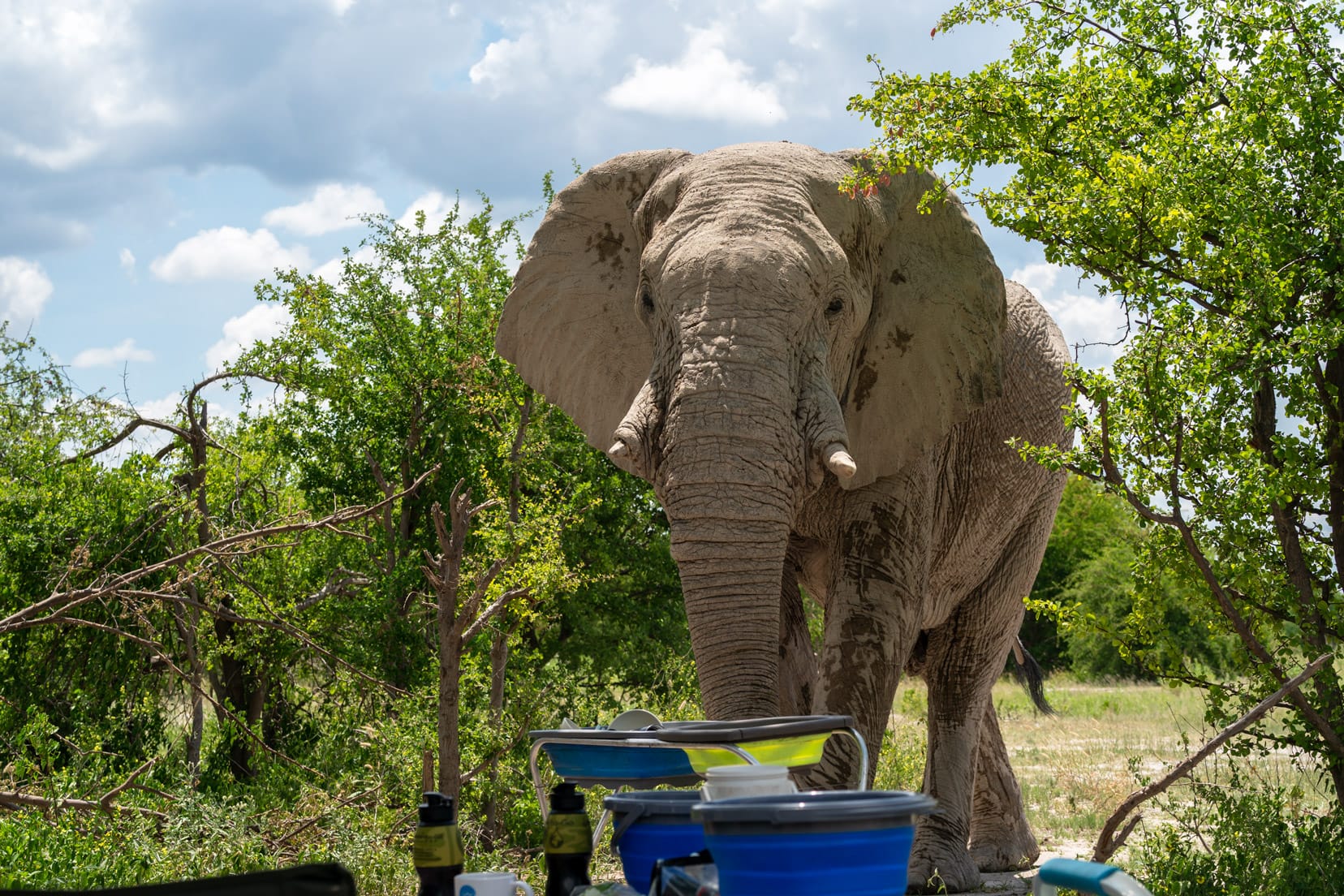
2. Join Overlanding Botswana Facebook Groups
For more overlanding Botswana tips from other travellers, you might like to join Facebook groups such as DriveBots, Overlanding Africa or Travelling Namibia and Botswana.
Each group is a community of like-minded travellers happy to share their experiences. They provide a treasure trove of knowledge and information.
We are members of all of the above and found them invaluable, both while we were planning and whilst travelling.
You can also follow us on Facebook and contact us if you have any questions you think we can help you with.
3. Learn the Botswana Courtesy
A show of respect in Botswana, independent of age or gender, is to accept or give something with your palms showing.
The method is to either use both hands to accept/receive or use one hand to accept and your free hand placed palm down on the forearm of the accepting arm.
A handshake (predominantly man-to-man) is a 3-stage action: grasp of the hands in a traditional handshake followed by a grip of the thumbs and a final grasp of the hands, all the time looking into the other’s eyes.
4. The Botswana Language
The official language of Botswana is English, but most locals also speak Setswana, with some of the older people only speaking that language.
We didn’t have any communication problems in regard to the language, but on several occasions, we found it difficult to get straightforward answers and information. We had to ask the same question in different ways. Each question elicits a different answer.
5. Cash and Card use in Botswana
Throughout Botswana, we found that some businesses wouldn’t accept Mastercard but did accept Visa Cards. This happened particularly in the more remote areas, and sometimes only cash was accepted.
Cash is king in the bush, and many of the national park gates, kiosks or ‘tuckshops’ only take cash, no card.
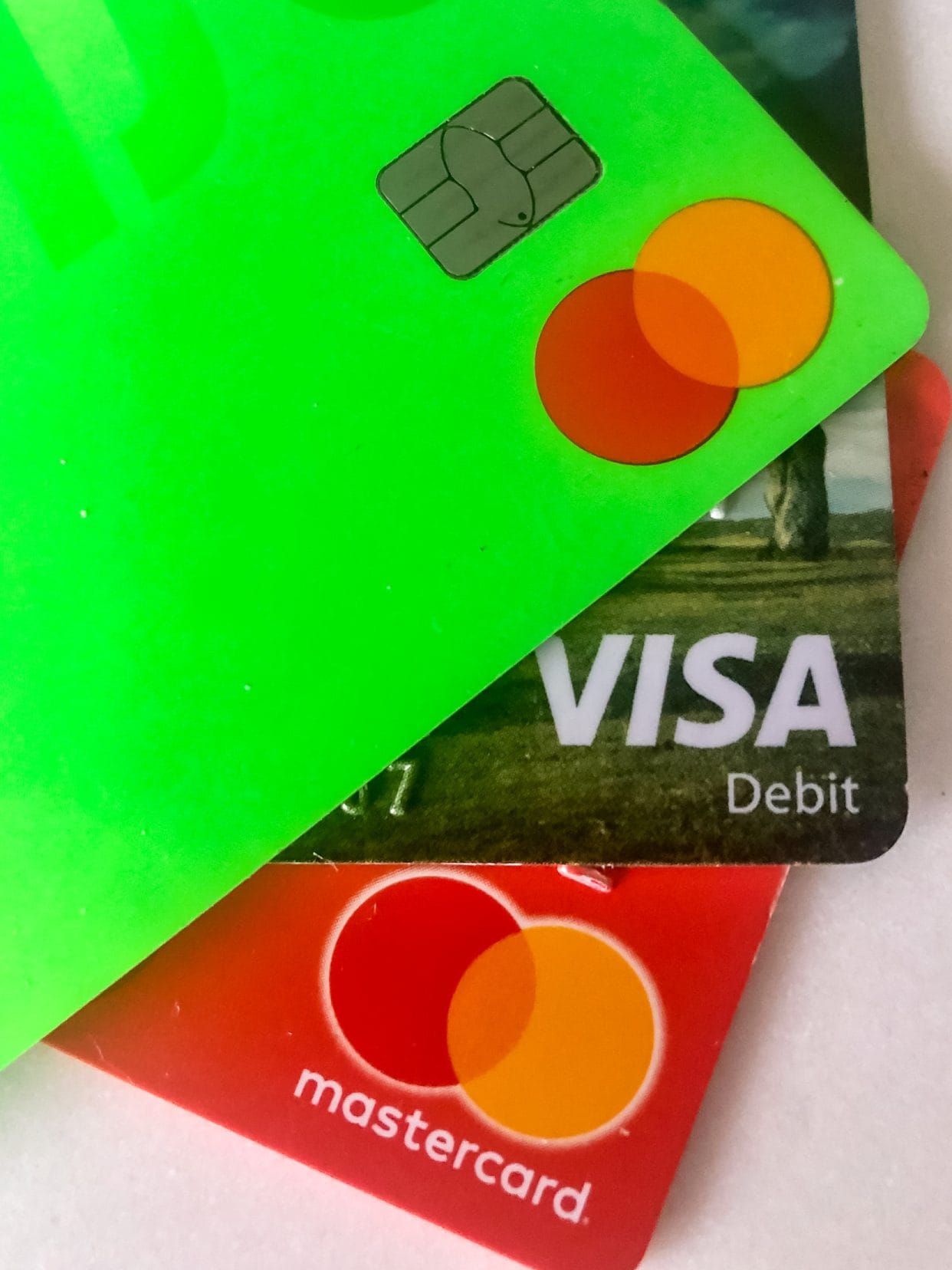
6. Botswana Currency
In Botswana, the local currency is Pula, but you’ll find that some places will accept US Dollars, Euros or South African Rand.
The locals seemed up to speed on exchange rates, but if you have enough Pula, it’s easier to use that.
Our 4×4 bush camper had mechanical issues in Moremi National Park, and we didn’t have enough Pula to pay the bush mechanics. However, we were able to pay them by scraping together enough cash made up of a selection of Pula, USD and South African Rand.
7. Botswana SIM Cards
Mascom network sim cards are said to have the best coverage in Botswana.
Not that network coverage is great once you are away from the towns, and even then, we found the internet regularly dropped in and out.
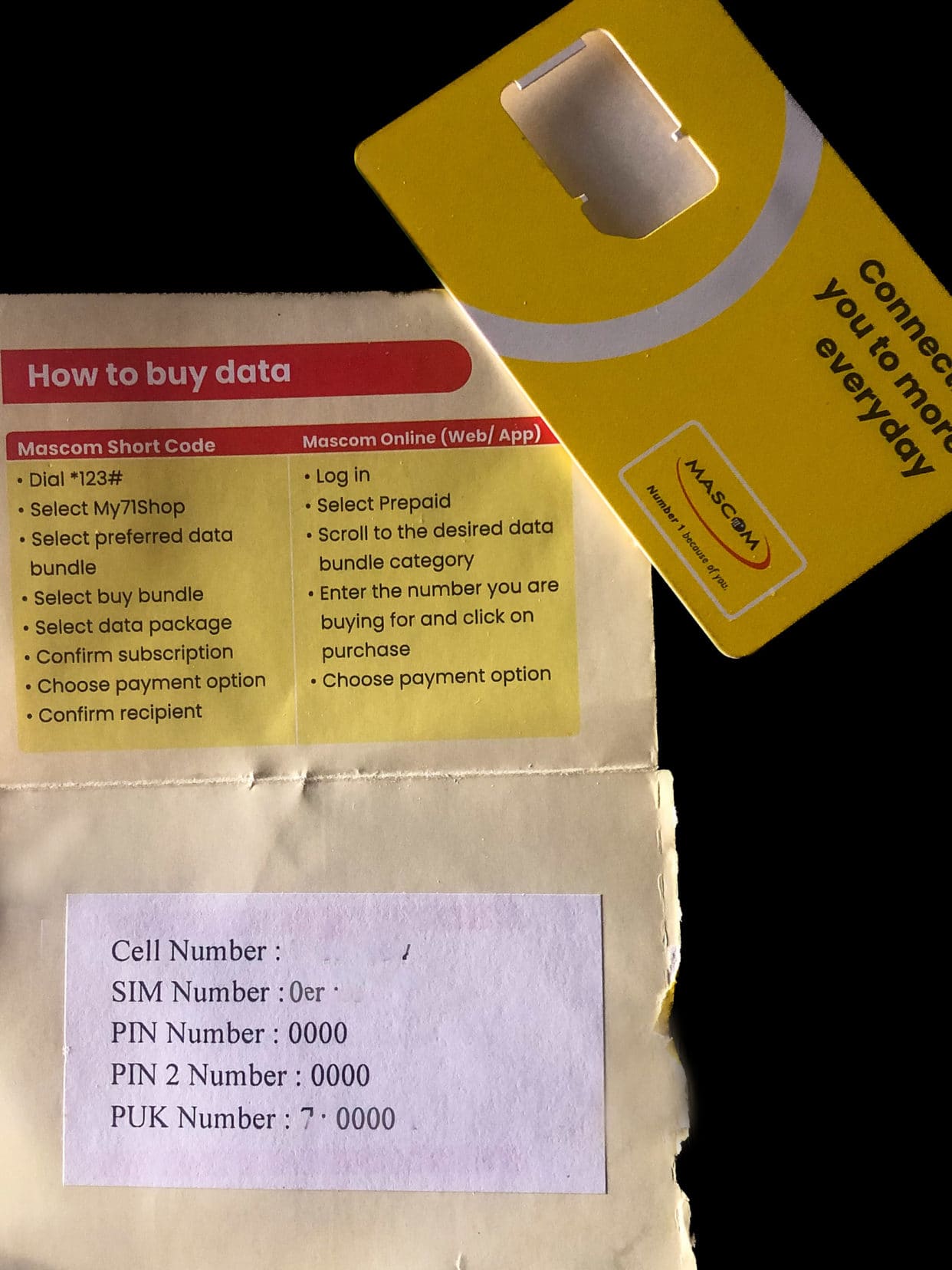
You can buy a sim card at shops selling Mascom products and post offices. Locals normally know where you can get one, so ask around.
The SIM card needs to be registered by calling Mascom. They will ask you a series of questions and also ask for your passport details.
You can then use the Mascom app to add credit.
8. Remember You Are On Africa Time
In Botswana, you need to expect things to take longer than you might consider normal.
There is a relaxed pace of life there, and no one is in a hurry.
Several times, we were told to wait a minute, and that minute turned into at least an hour!
I had to laugh when I was in Toyota trying to get the Hilux steering fixed. There were many times when the mechanic would say one moment, as he left me by the car. Not one ‘moment’ was less than half an hour.
One time, he said he was just going to get a different spanner. After about 45 minutes, I went in search of him.
He’d gone to lunch.
It is Africa. It takes the time it takes.
9. Bring your Happy Face
Botswana people will nearly always greet you with a “Hello, how are you?” accompanied by a big smile.
Funnily enough, they may also say, “I’m well, thank you,” before you even get the chance to answer or ask them how they are.
Most of the time, they will be able to speak English, but a smile is always a good ice breaker, no matter if you both speak different languages.
10. Useful Business Contacts in Botswana
We used these businesses in Botswana and can highly recommend them:
- Aquarite: Purified water distributors located in both Maun and Kasane.
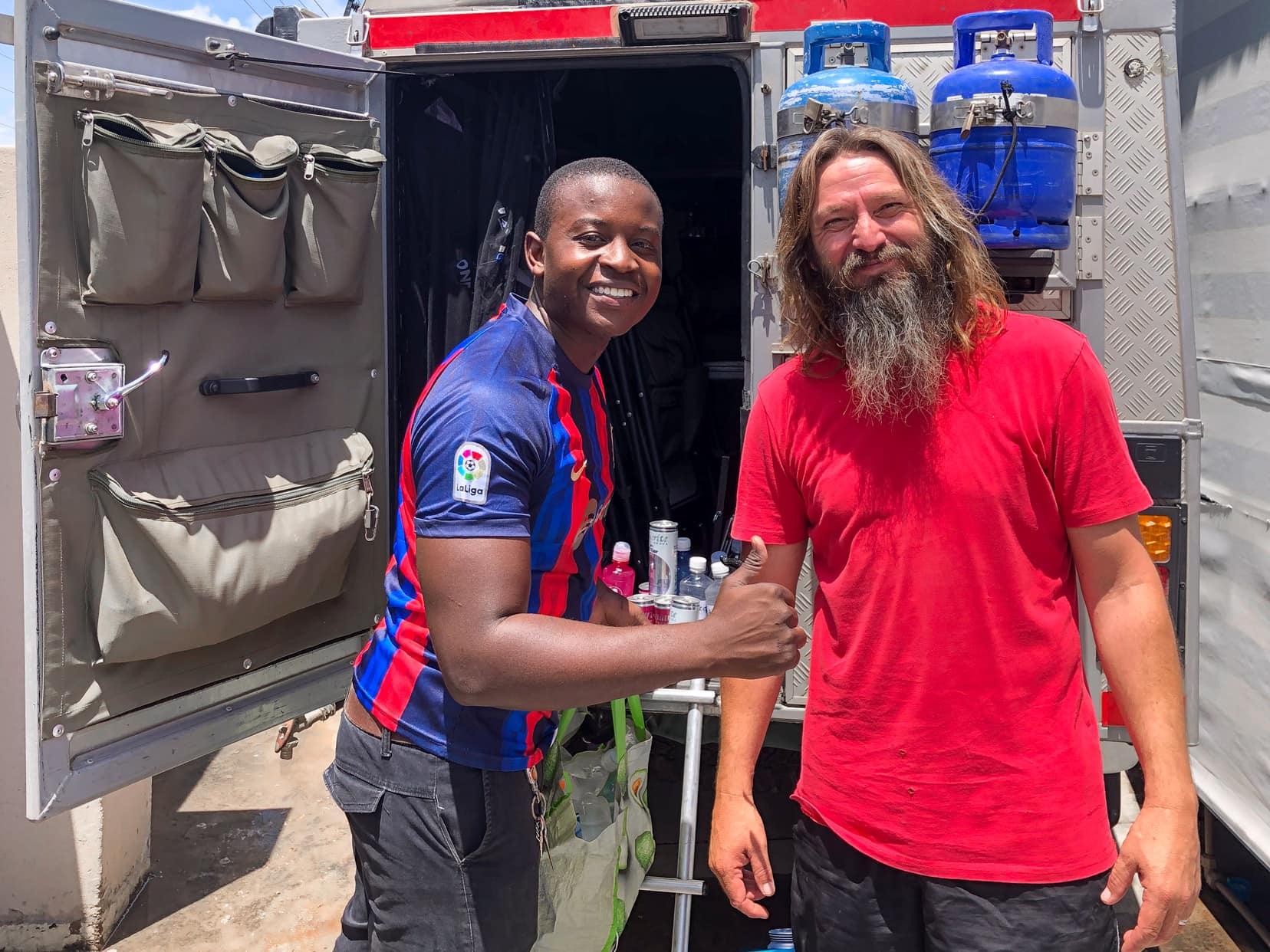
- CanvasZone: Insect screen fitment located in Maun.
524 Mophane Ave, Maun, Botswana
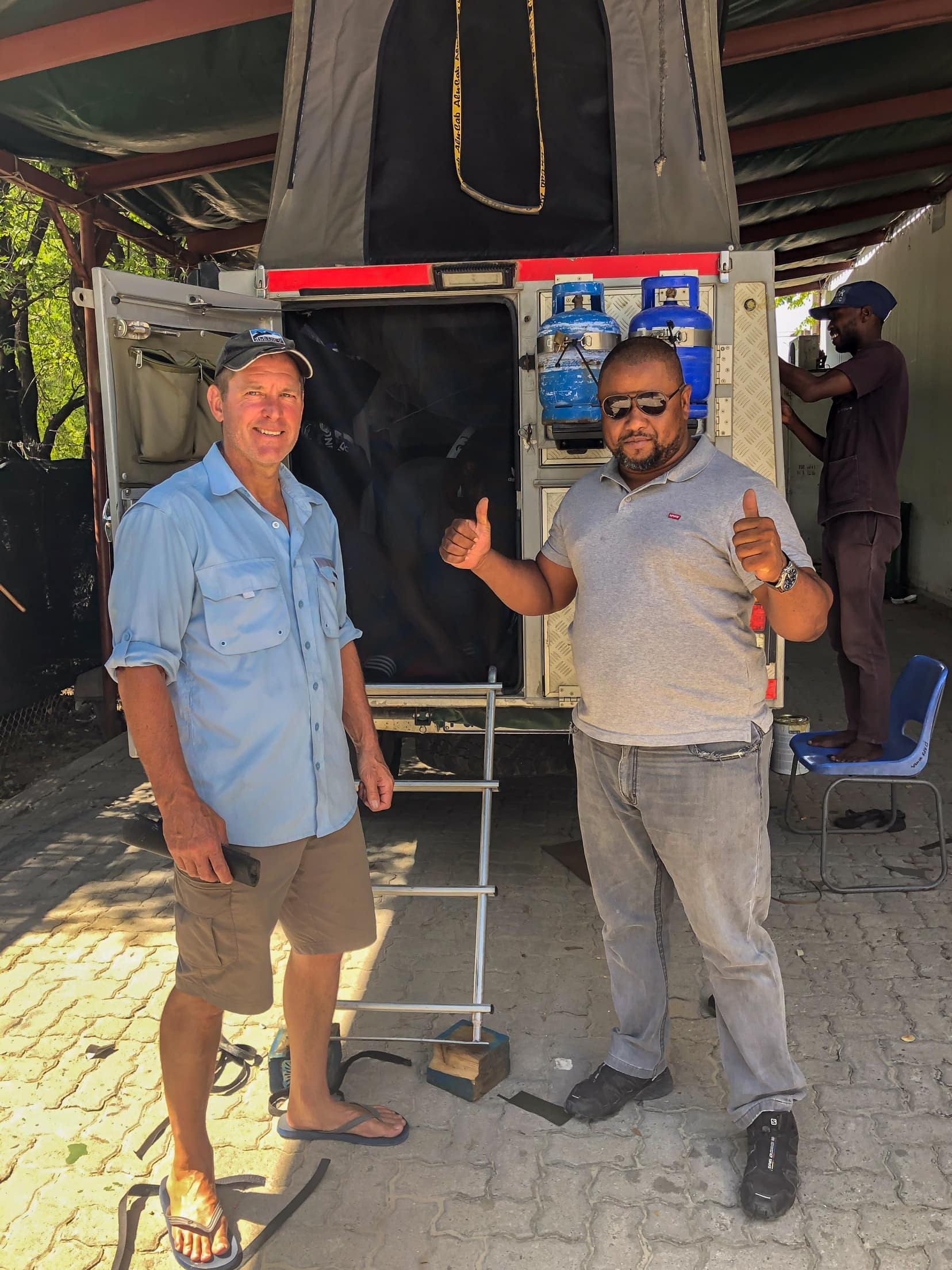
- The Maun Studios and other Maun accommodation options
We have stayed a few times at the serene Maun Studios. A beautiful, quiet setting right beside the river.
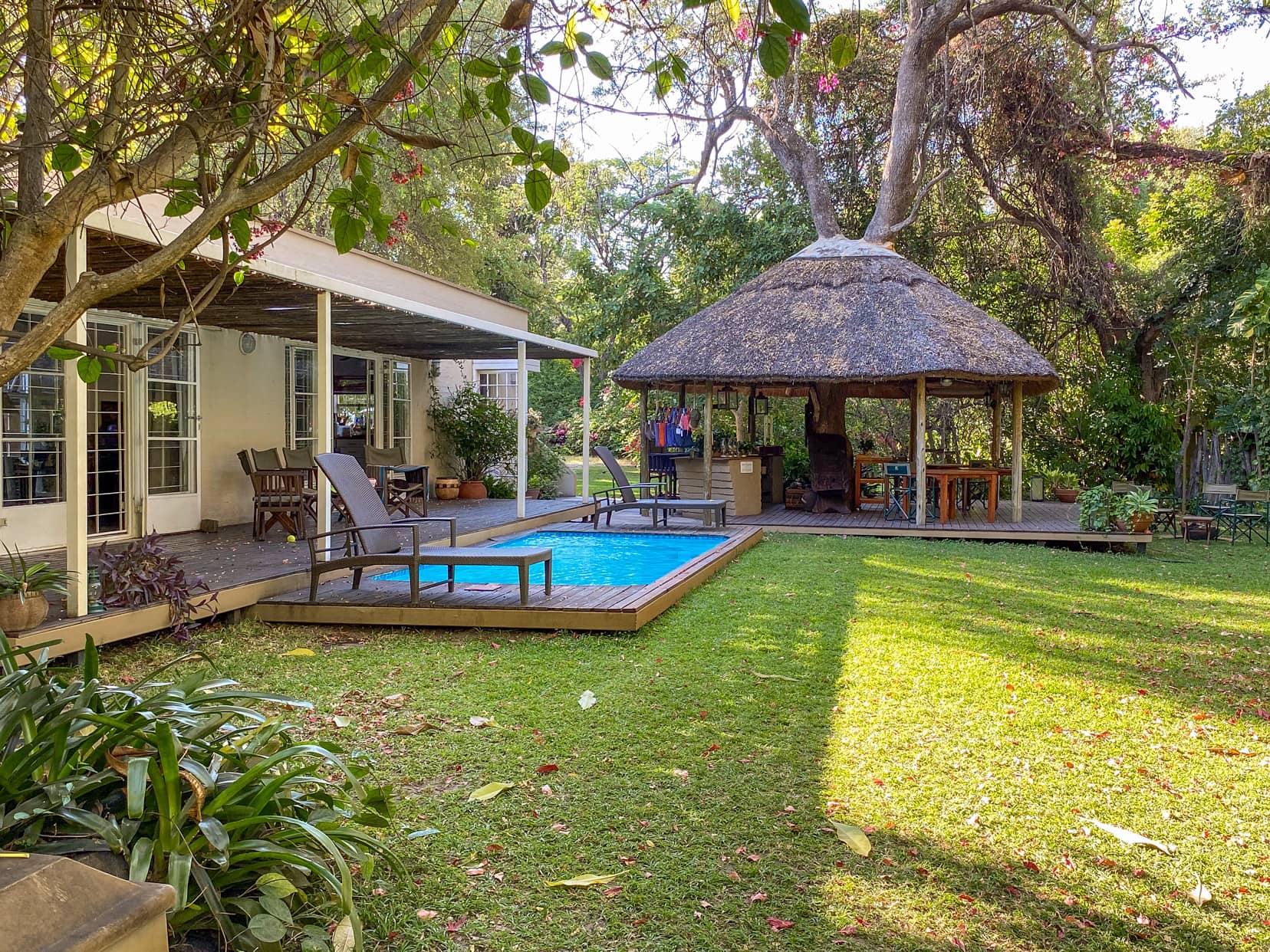
- Car Mechanics – Mikey and Patrick, located in Kwai
These two mechanics got us going again while we were camping at Southgate, Moremi National Park in Botswana. They are definitely good guys to know in the bush. Keep their WhatsApp numbers handy:
Mikey: +267 7589 5752
Patrick: +267 7739 2116
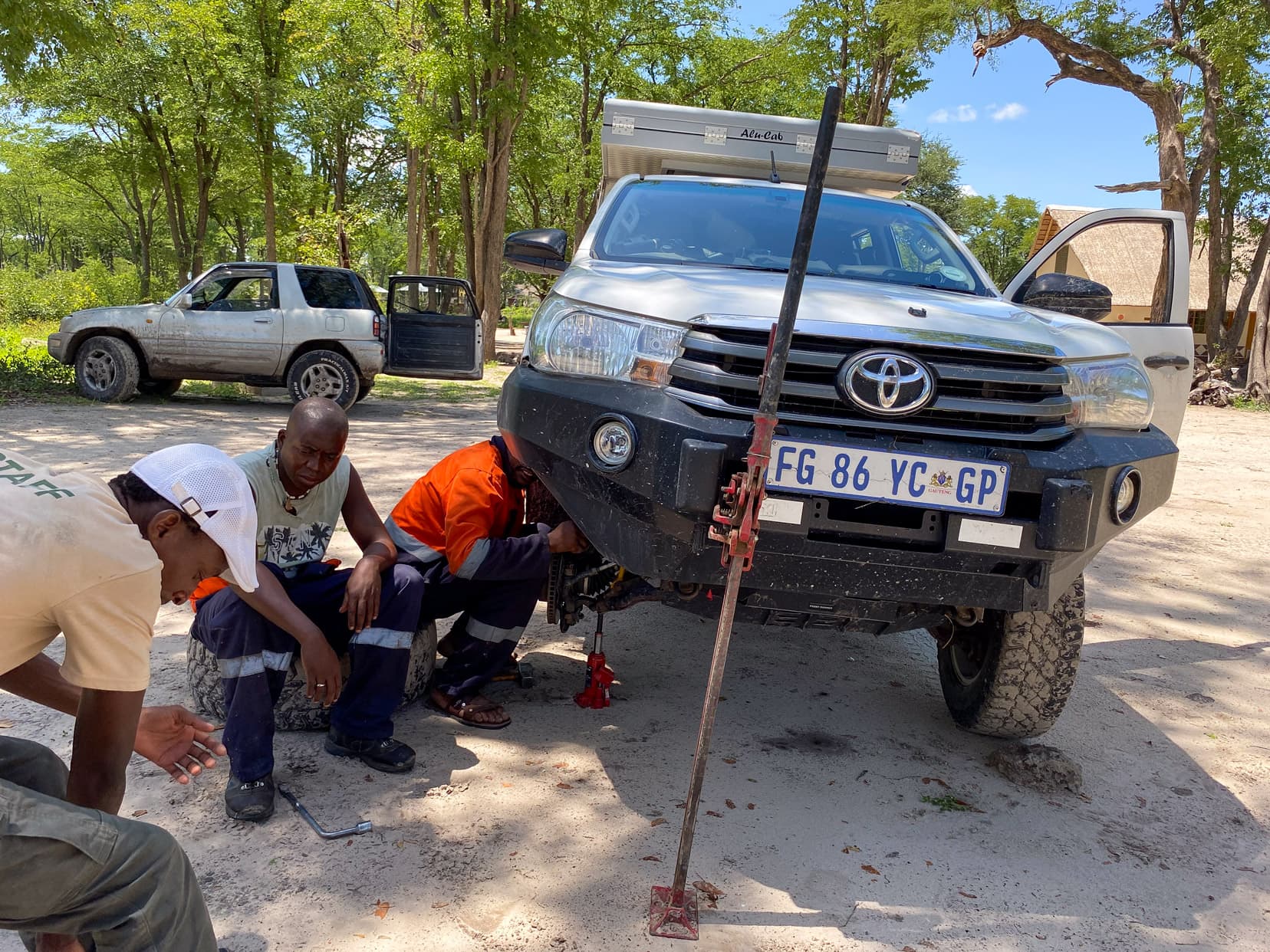
Vehicle Tips for Overlanding Botswana
Overlanding in Botswana can be an incredible adventure, exploring its incredible wilderness and experiencing the thrill of off-road travel.
However, it’s important to remember these vehicle tips to ensure you have a safe and enjoyable trip.
Here are some key considerations in relation to your overlanding vehicle for Botswana:
11. 4×4 Rental Choices
Most international visitors hire their vehicle, but because we planned to travel extensively through Africa over some years, we bought our 4×4 Hilux bush camper with a pop-up rooftop tent.
But the most popular option for most overlanding trips in Botswana is to hire a 4×4 with a roof tent.
There are some great 4×4 rental companies that offer different versions of fully kitted-out safari bush campers ready to hit the road and tackle your overland tour.
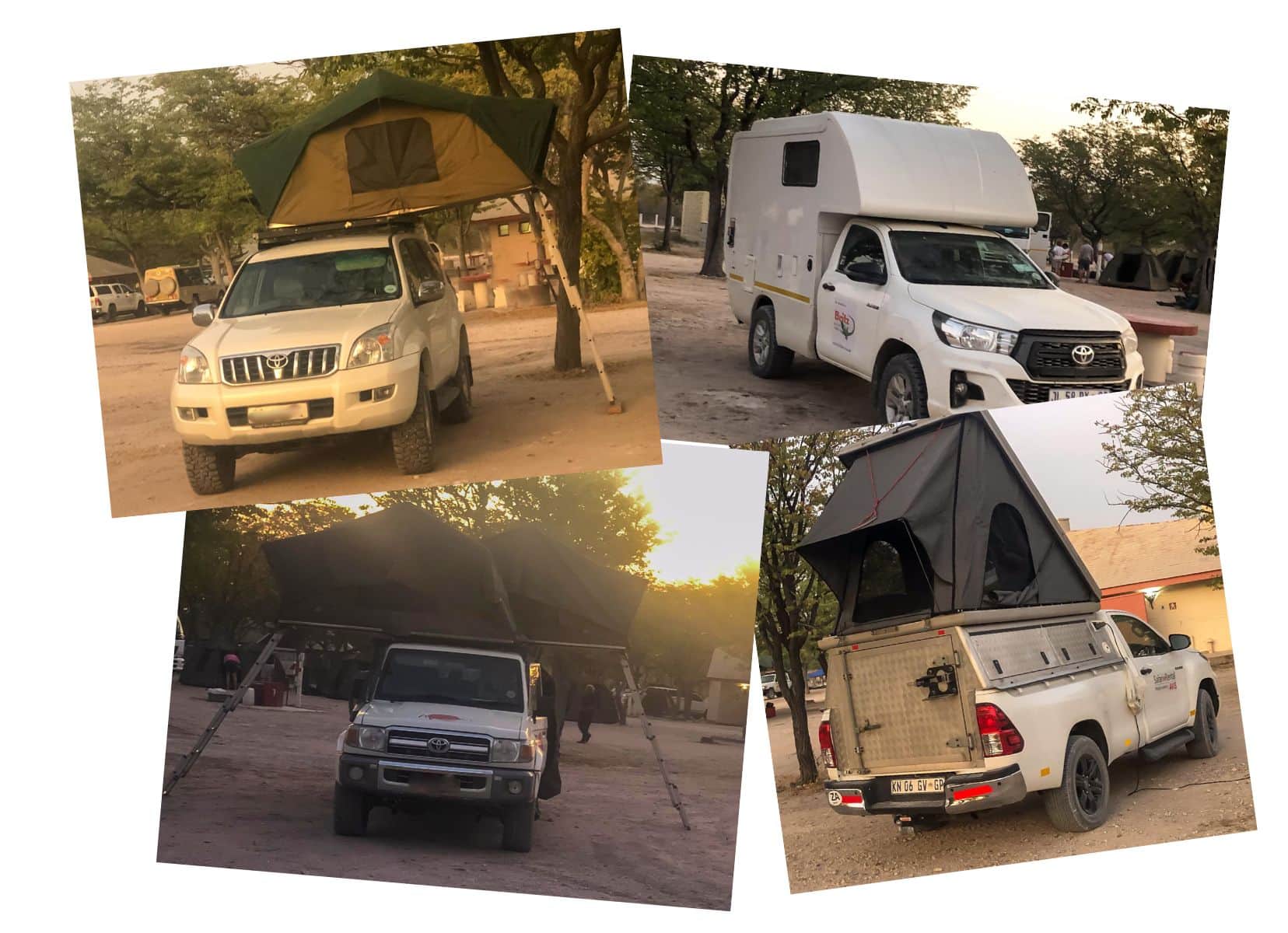
There are a variety of choices of 4x4s. From small 4×4 motorhomes to those with different types of pop-up tents and a variety of other 4×4-equipped vehicles to choose from.
We recommend using Motorhome Republic to source a great deal for you for the available 4×4 campers in Botswana. They source campers from Britz, Avis Safari, and other local businesses.
It’s worth getting a quote from them, at the very least. We used them when we travelled throughout Europe in a motorhome, and their customer service went above and beyond in finding the best deals for us.
🚐 Thinking of Hiring a Camper in Botswana?
We recommend using Motorhome Republic to find you the best deal – they search all the local reputable African rental companies, including the most popular (we’ve seen them everywhere here), Avis and Britz
They do all the hard work for you and have a PRICE BEAT GUARANTEE
12. Be aware of Vehicle Wear and Tear
Driving through muddy water can leave sediment on the brake pads and rotors. This sediment acts as an abrasive between the two when the brakes are applied, much like sandpaper, so you can expect higher than normal wear.
We were almost bogged in muddy water in Moremi National Park, and after a few heart-stopping moments, I managed to get the car out.
The noise it was making was a horrendous screeching, which, after investigation, turned out to be the minimum wear indicator on one of the brake discs.
Yep, I was due some new front discs.
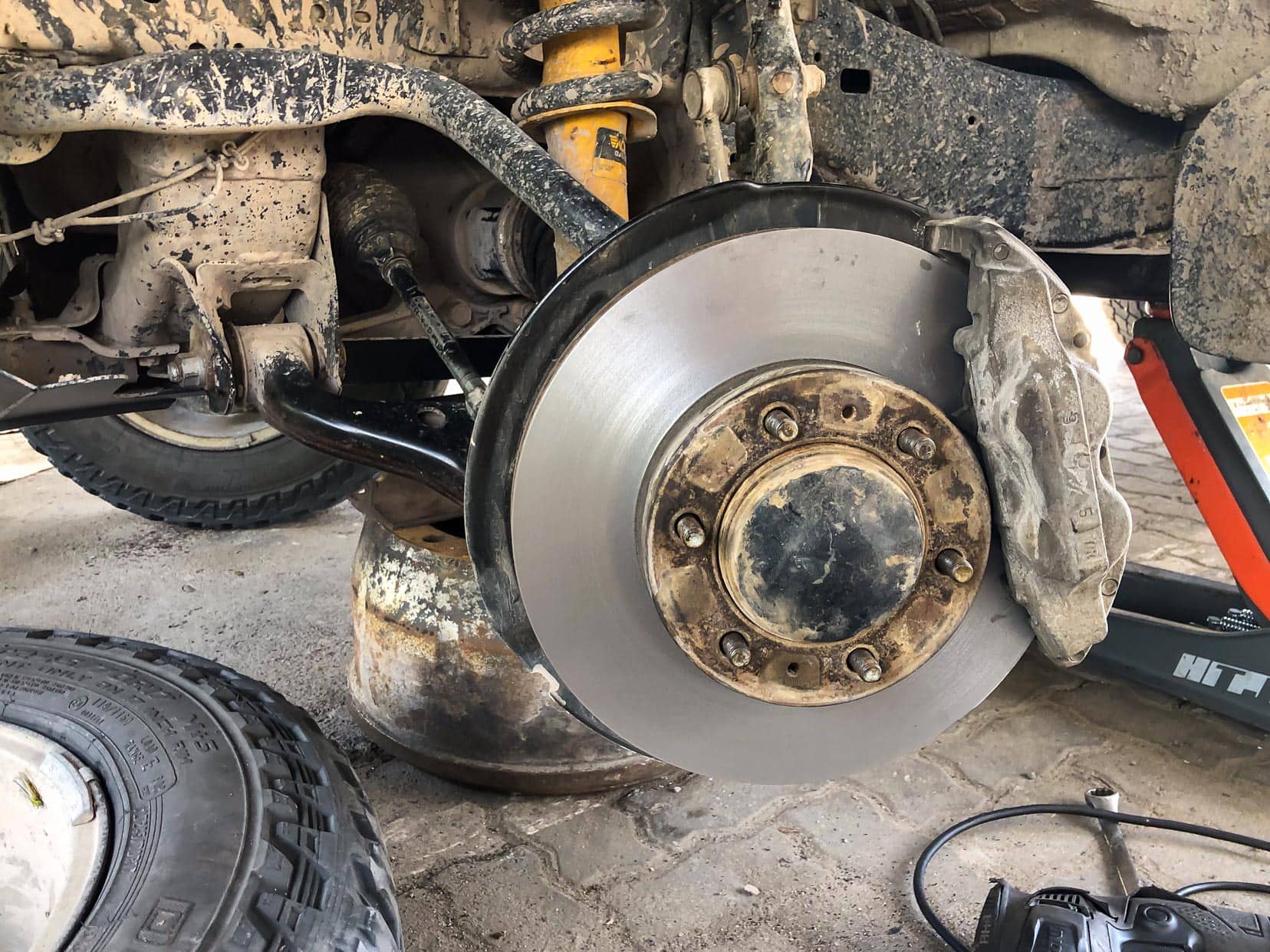
And just to be sure that the front brake system was working as best as it could, I had both the front rotors skimmed.
13. Tyres for your Overlanding Botswana Trip
All-terrain tyres with good tread are the standard tyre type for overlanding; however, you may come across mud-terrain tyres or a cross between the two.
On our Hilux, we use the all-terrain Apollo Alterra LT 265/65/16 tyre.
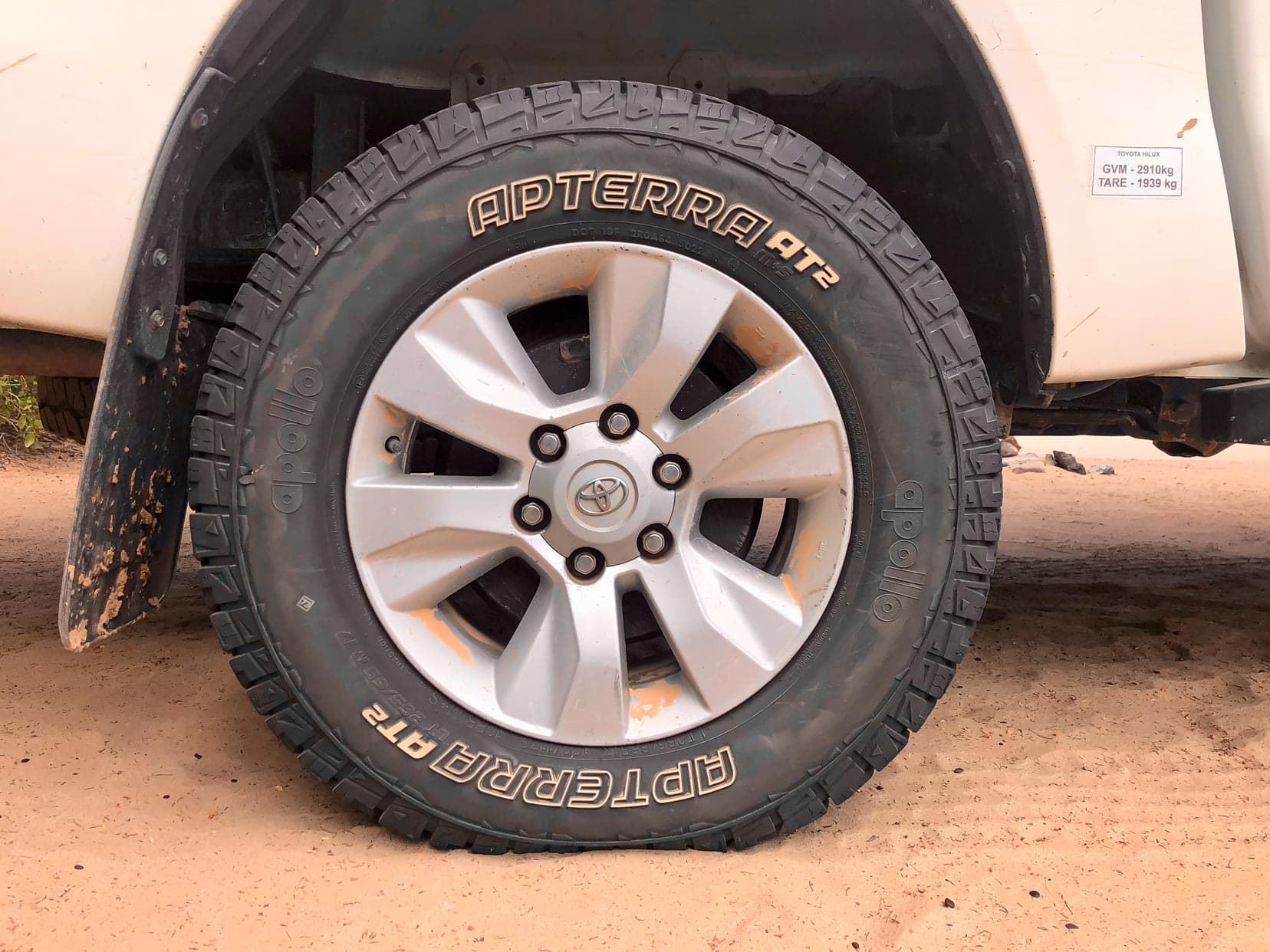
A recommendation is to check the tyre condition (e.g. existing tyre plugs, tyre rubber uneven wear) and the age of the car’s tyres. Work off the 5-year rule from the date of manufacture – any tyres older than 5 years should prompt you to consider changing them.
Our tyres were just over 5 years old, and we had a blow-out while driving on a dirt road in the Kgalaghadi Transfrontier National Park. Low tyre pressures and heat build-up in the tyre, repeated over time, are factors that reduce a tyre’s longevity.
Normally, changing a tyre isn’t too difficult, but when you are keeping an eye out for lions, leopards, buffalo and elephants and it’s the sweltering heat of the day – changing a tyre isn’t so easy or appealing.
14. Check Tyre Pressures
Depending on the weight of your vehicle, the normal on-road tyre pressures will need to be reduced when going off-road.
There’s no magic ‘one tyre pressure’, that will do the job for all conditions. Tyre pressures will depend on the surface conditions such as sand, mud, rocks or gravel.
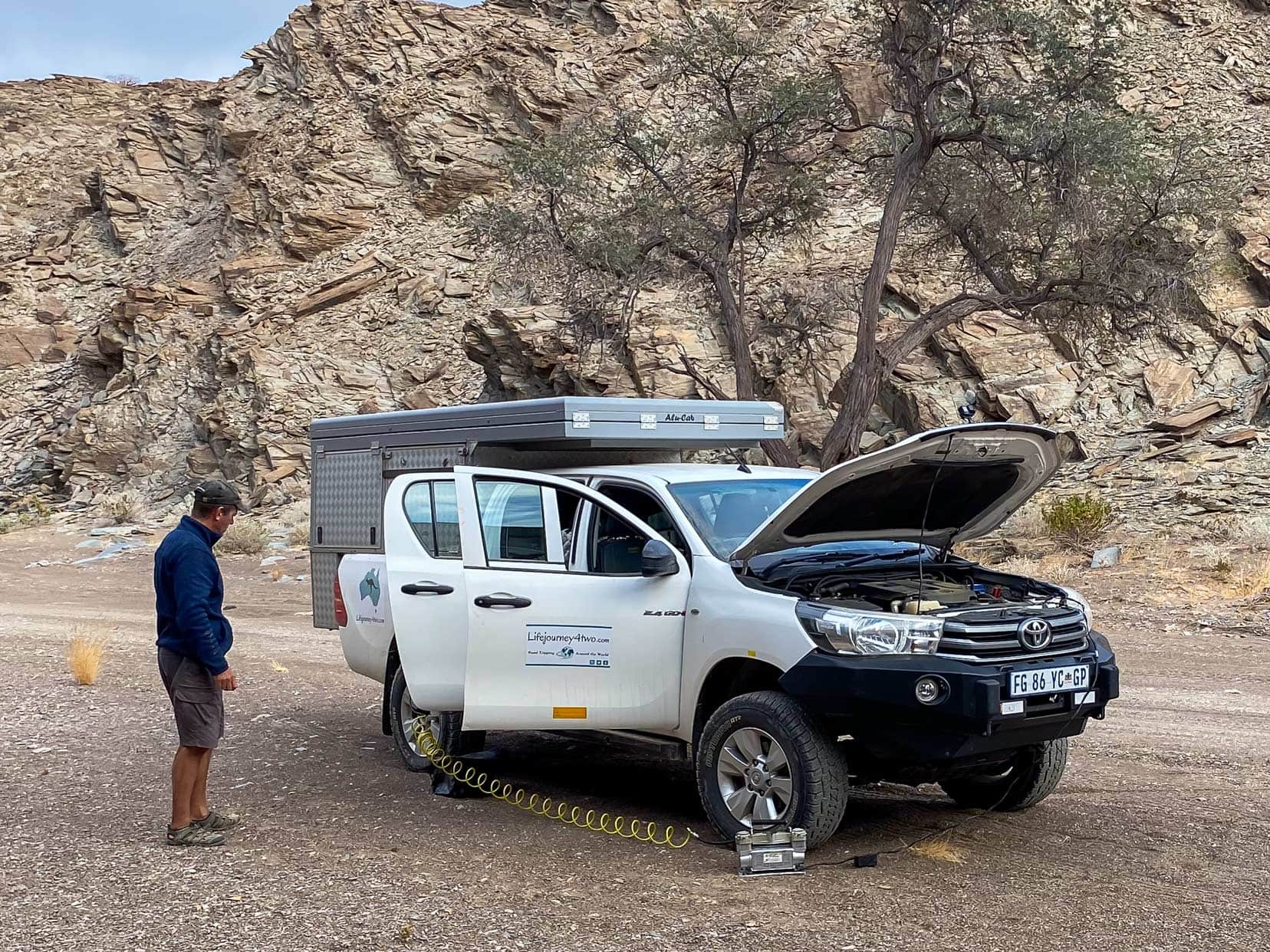
In the mud, with our 2.5-tonne Hilux bush camper, I found that 2 bar pressure worked well for me, whilst for deep sand, I normally dropped down to about 1.5 bar.
Driving Tips for Overlanding Botswana
These tips for driving in Botswana will help you prioritise your safety and follow responsible travel practices while enjoying your overlanding experience in Botswana.
15. Drive on the Left-hand Side
In Botswana, ensure that driving is done on the left-hand side of the road. Overtake on the right-hand side.
16. Maps for Overlanding Botswana
I can’t help but talk up the Tracks4Africa maps.
We have the Tracks4africa app and the hard-copy maps.
Both are superb.
The app works off-line and provides real-time GPS positioning, which overlays your position on the map.
The hardcopy maps have the added information of giving realistic driving distances with their respective drive times, which is super handy.
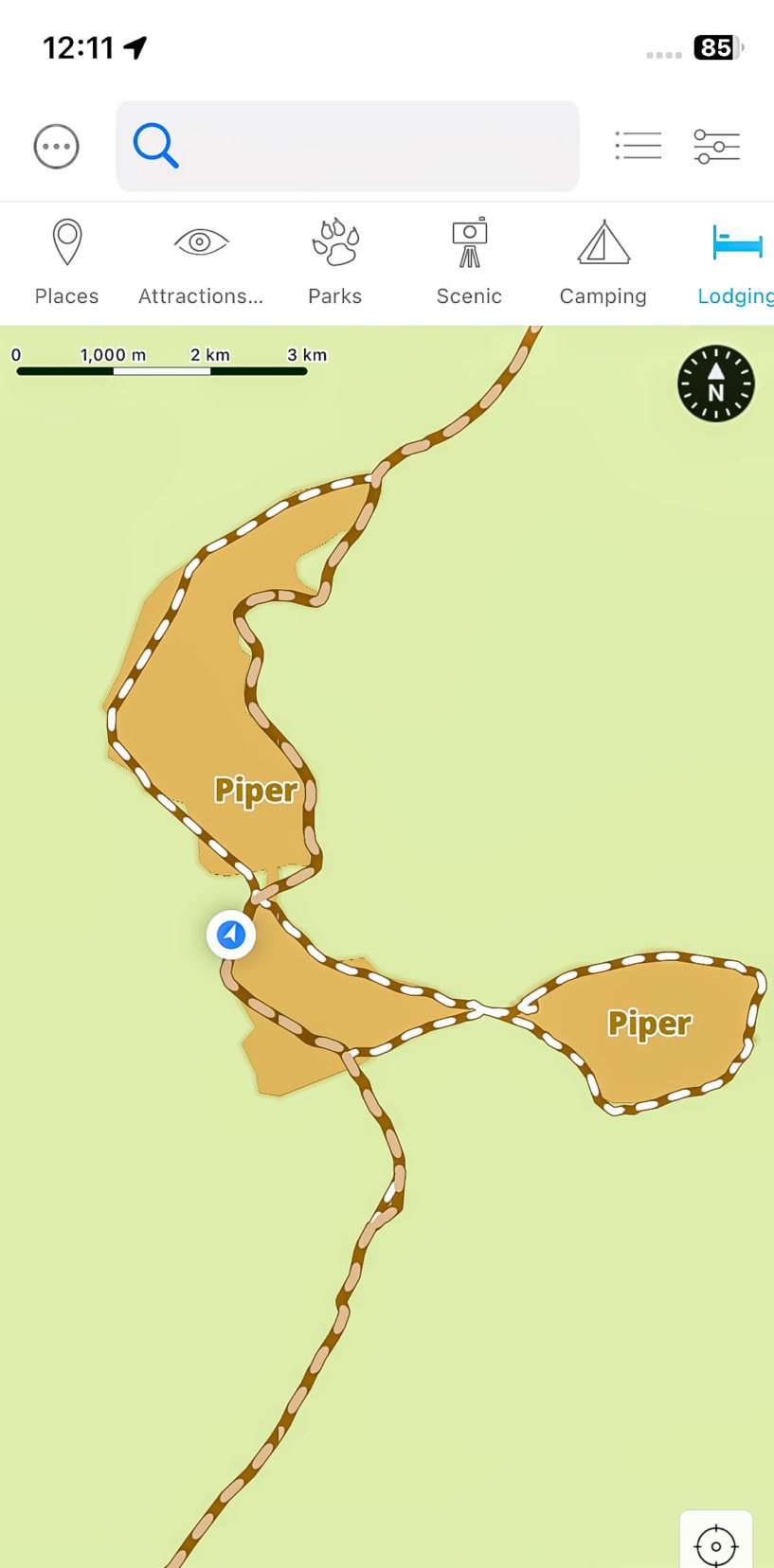
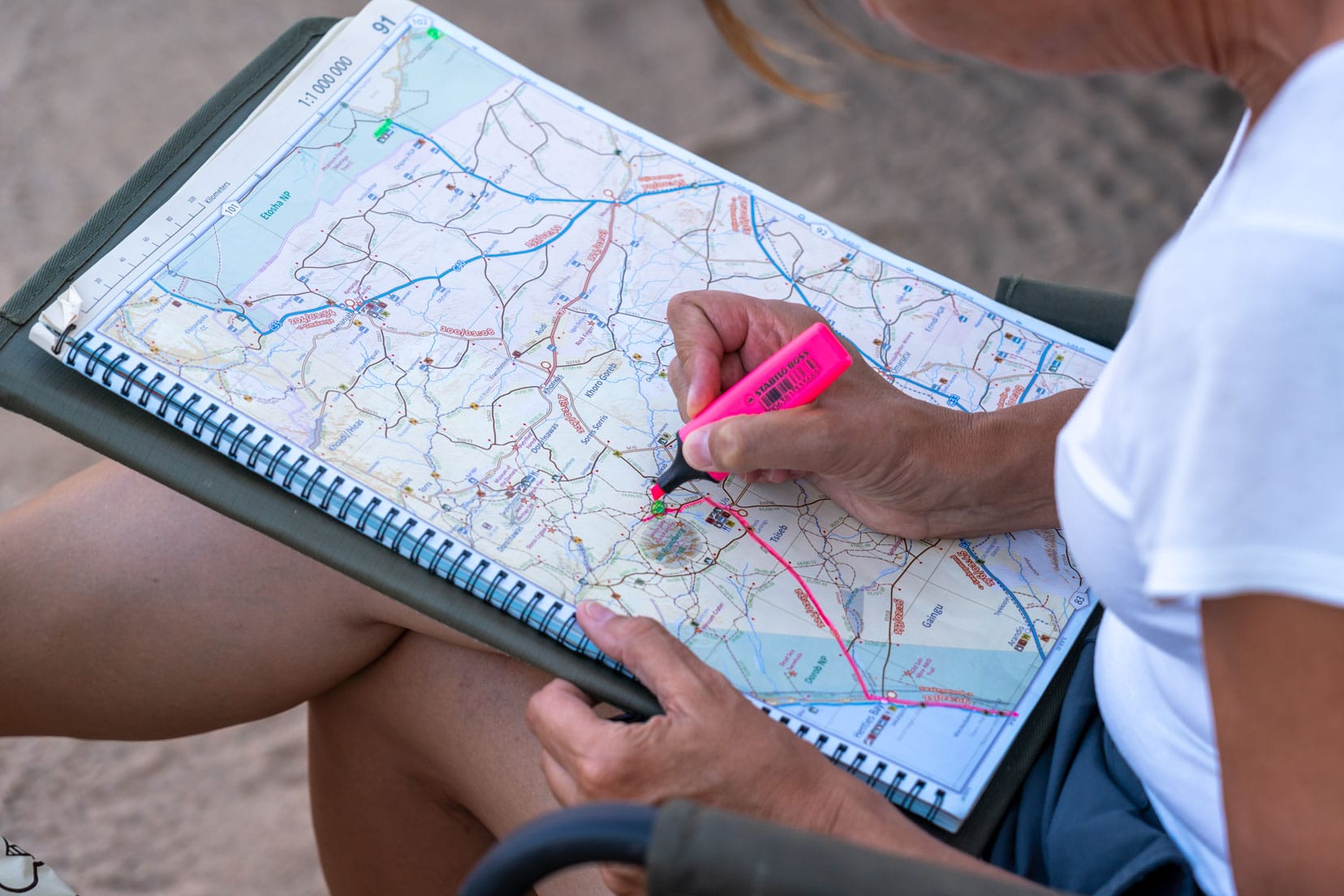
Both the app and the hard copy map also provide locations for services such as campsites, lodges, fuel, shopping and much more.
Forget your Google Maps out in the bush.
Without a reliable internet signal, this isn’t going to work. You’ll need something fit-for-purpose, and Tracks4Africa maps are a fantastic travel companion. To be honest, Tracks4Africa offer plenty of travel-worthy practical products.
✅ We can’t recommend Tracks4Africa enough if you plan to self-drive in Botswana.
👀 Check it out
on Amazon here.
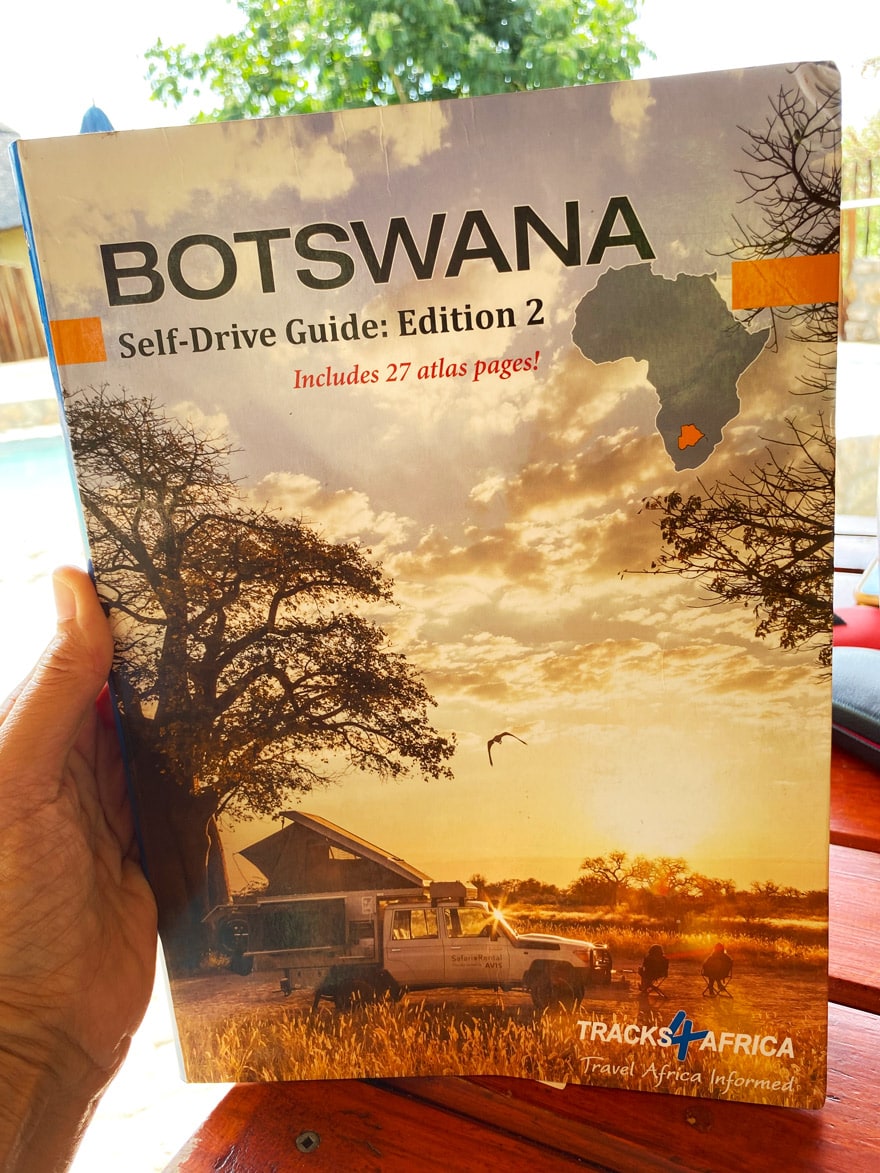
17. Botswana’s Vet Fences
Vet fences (veterinary fences) are literally roadblocks that occur across certain roads in Botswana to prevent the spread of ‘foot and mouth disease’ from wild animals to cattle.
In Botswana, no raw meat is allowed past the vet fence if you are travelling north to south OR west to east.
VET Inspectors will check to make sure you aren’t carrying uncooked meat, and you’ll also be required to place your shoes and any other footwear on a disinfectant pad.
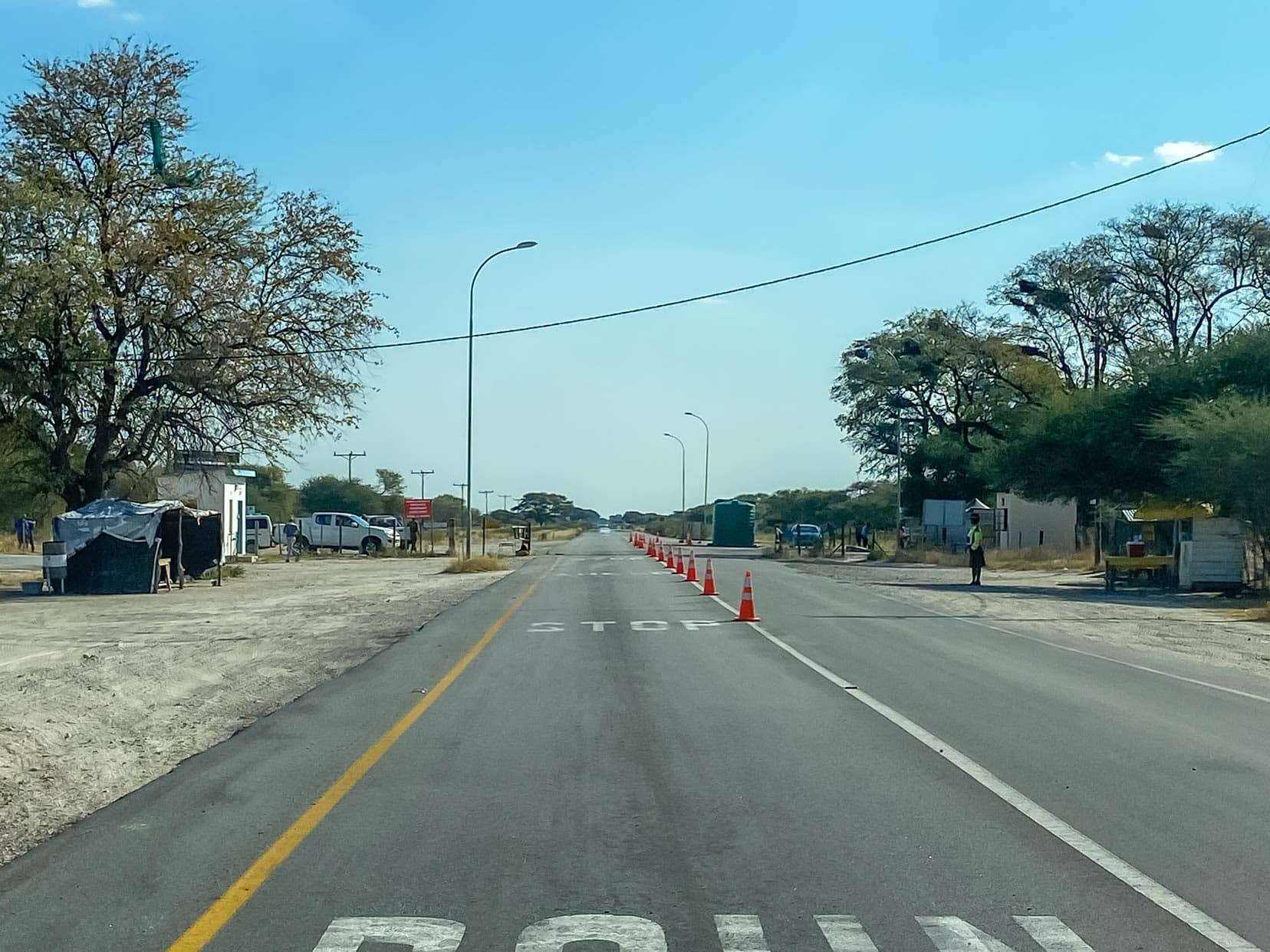
Just after arriving in Botswana, we were confused about which direction to take raw meat. At the time, we were travelling west to east.
The inspector asked if we had raw meat, and we immediately notified him of our mistake and opened the fridge to hand it over.
To our surprise, he closed the fridge lid.
Confused, we opened it again to remove the two steaks we’d just bought.
He closed the lid again. “What can we do about this?” he said.
“Well, you can take the steaks,” we replied.
Thinking we were going to be fined or something, the inspector then said he would take a can of coke and forget the matter.
Unfortunately, we didn’t have a can of Coke, but we did have a bottle of Pepsi. I was about to hand over the Pepsi when I could see the inspector shaking his head.
Pepsi, it seems, is not considered ‘currency’. And it was a 2-litre bottle too!
He was unhappy with the alternative I was offering, so he asked for money instead. Unsure of the going amount, I gave 30 pula (about AUD$3). He seemed happy enough as he popped it into his pocket and walked away.
All the other times we passed through the vet fences, we made sure we didn’t have any raw meat – so we don’t know if this would have happened again.
However, it’s useful to know that bribery and corruption do actually occur within Botswana.
After the inspection and as you leave, you’ll need to drive through a disinfectant solution.
Cooked meat is allowed past the vet fence, but be aware that the rules regarding what can and can’t be taken past this inspection point can change. Sometimes, the restriction will extend to dairy products and vegetables.
The best way to keep up to speed on the rules is to ask the question on a Facebook Group such as DriveBots.
The Tracks4Africa maps show the locations of the vet fences.
18. Use Headlights on Public Roads
Use your headlights on all public roads when driving in Botswana.
Although this isn’t mandatory in Botswana (as in Namibia), it will increase your visibility on the road to other drivers.
When driving in the parks or reserves, I keep my headlights off to avoid disturbing wildlife.
19. Speed Limits in Botswana
Unless otherwise signed, a 120 k/h speed limit is on the main roads outside the towns.
Inside the town, limits are generally 60 k/h or sometimes 30 k/h.
It’s quite normal to see police enforcing these speed limits with speed cameras at the town perimeters where speed limits change.
20. Road conditions in Botswana
Sealed roads in Botswana are generally in good condition unless signed otherwise.
The worst section of road we drove was the A3 between Nata and Gweta, with loads of deep potholes.
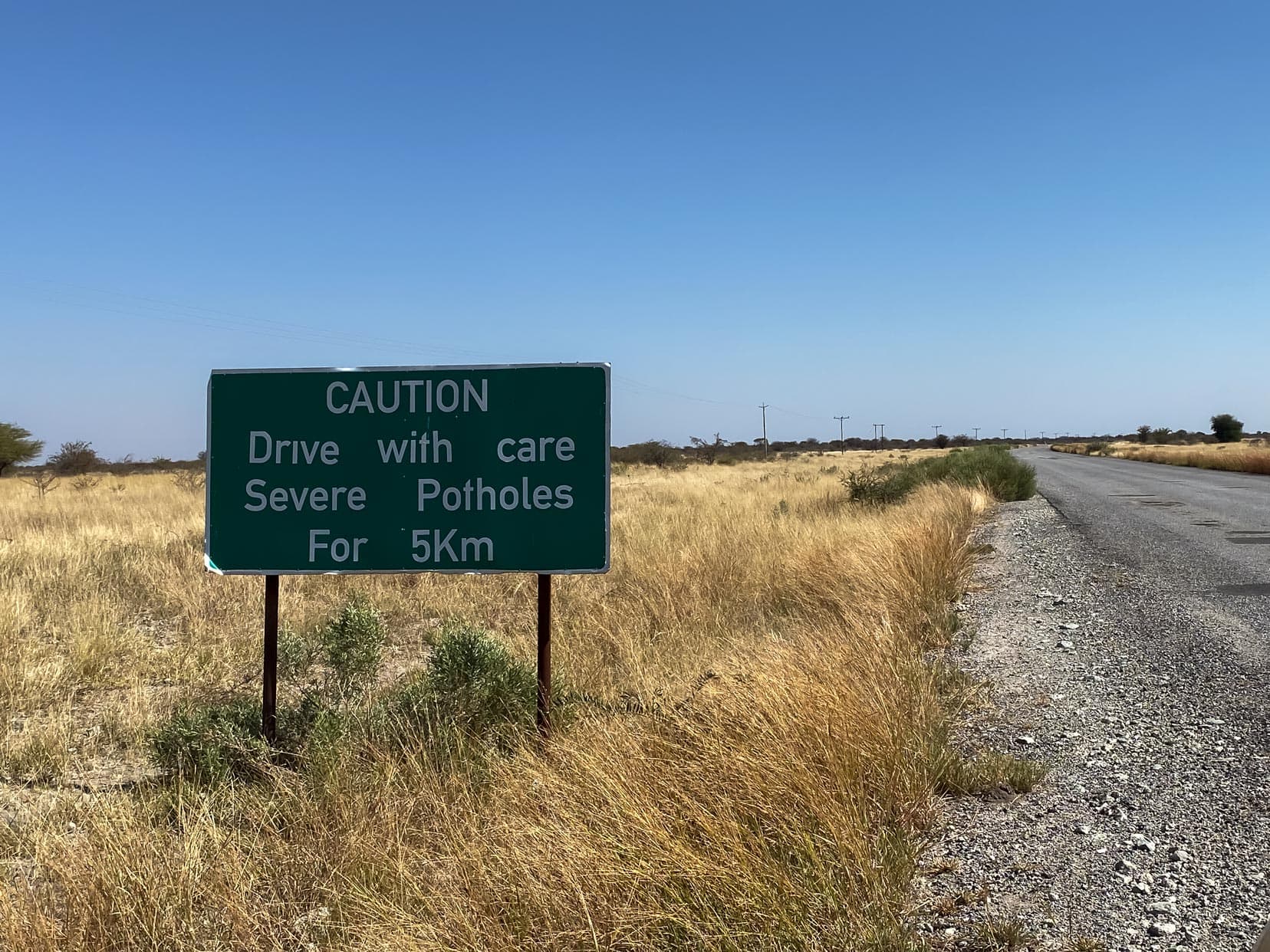
It goes without saying that once inside the National Parks, you can expect all types of terrain; deep sand, sticky mud, waterlogged tracks and lumpy, washboard corrugations.
This is also where the fun starts!
21. Watch out for Animals on the Road
Cows, goats, horses, and donkeys often graze close to the road and wander across regularly.
Also, many of the wildlife parks and reserves aren’t fenced, so you may also see elephants or other wildlife on the road in some places.
We saw elephants crossing the A3 between Nxai Pan and Makgadikgadi Pans National Park and also on the A33 that runs between Kasane and Nata.
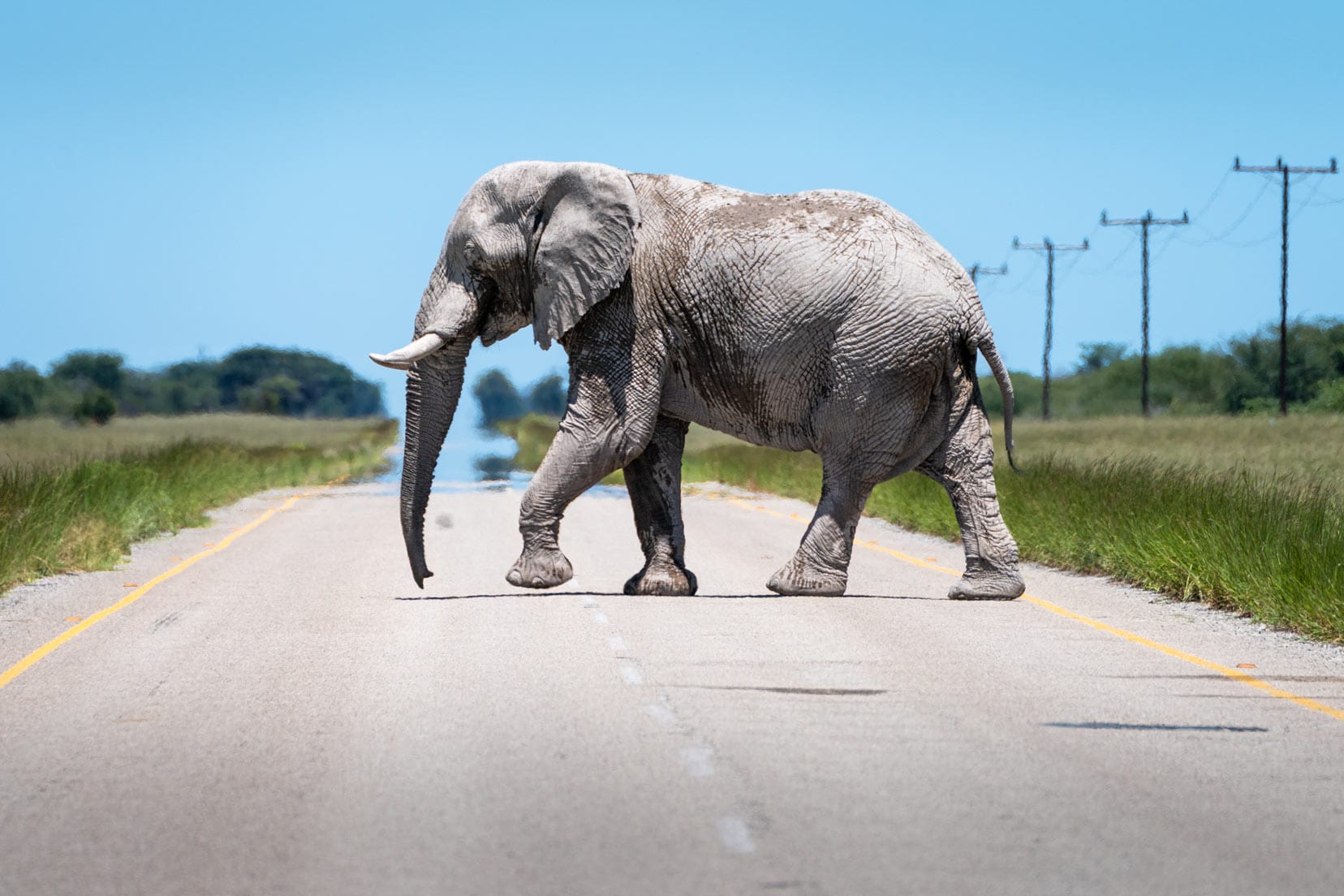
Slow down and give the animals time to cross. If there are cars behind you, use your hazard lights. Actually, you’ll see that Botswana drivers are good at using their hazard lights in general – animals or otherwise.
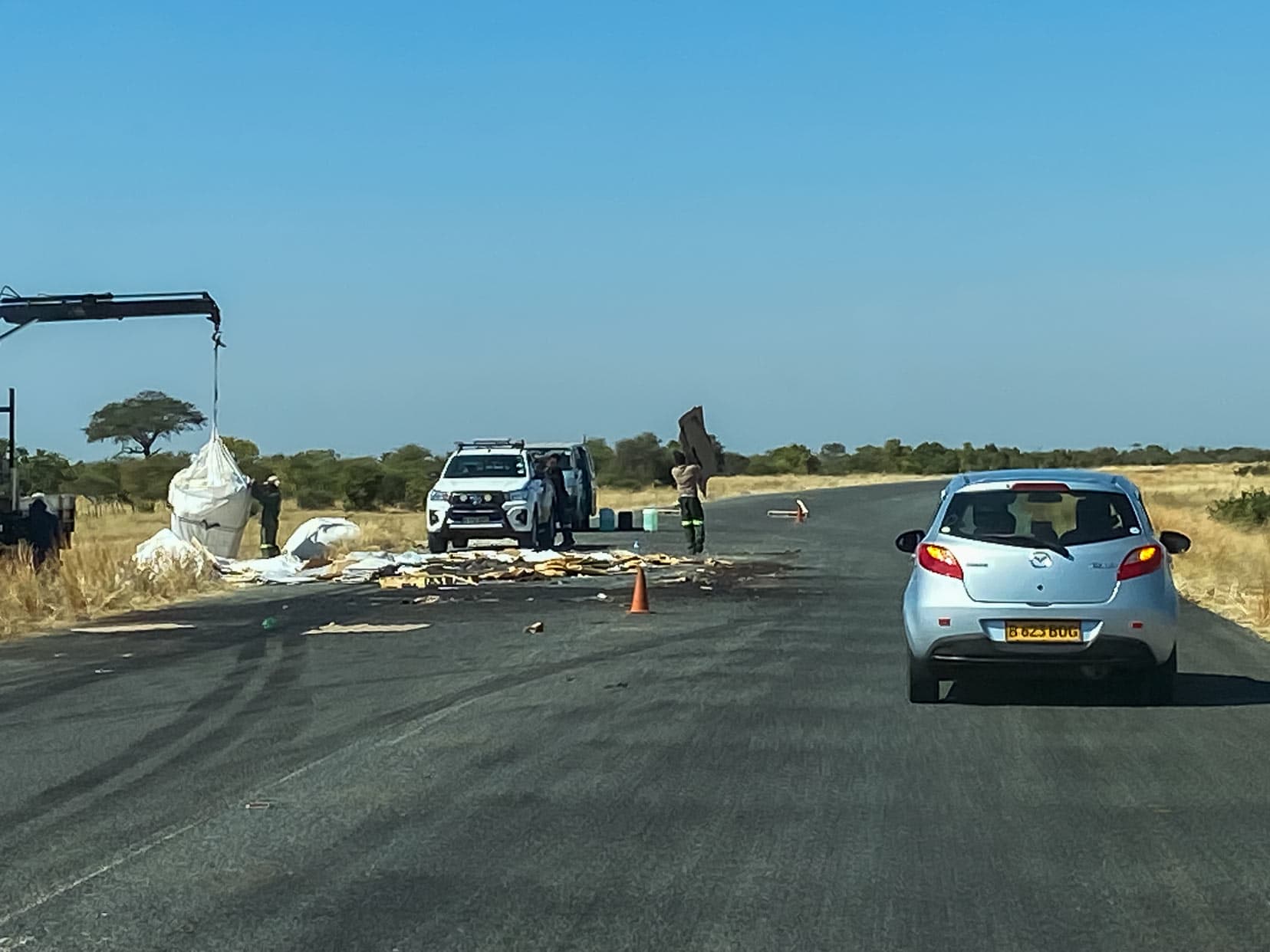
Avoid driving after dark, as it’s not easy to see animals on the side of the road, and more likely, one may run out in front of you.
22. Fuel prices in Botswana
In Botswana, fuel prices are regulated across the country, so fuel stations charge much the same.
You won’t find any fuel stations within the parks and reserves. The golden rule is to fill the tank up when the opportunity presents itself.
This is especially important if travelling from Maun to Kasane via Khwai and Chobe National Park, traversing Central Kalahari Game Reserve or Kgalagadi Transfrontier Park.
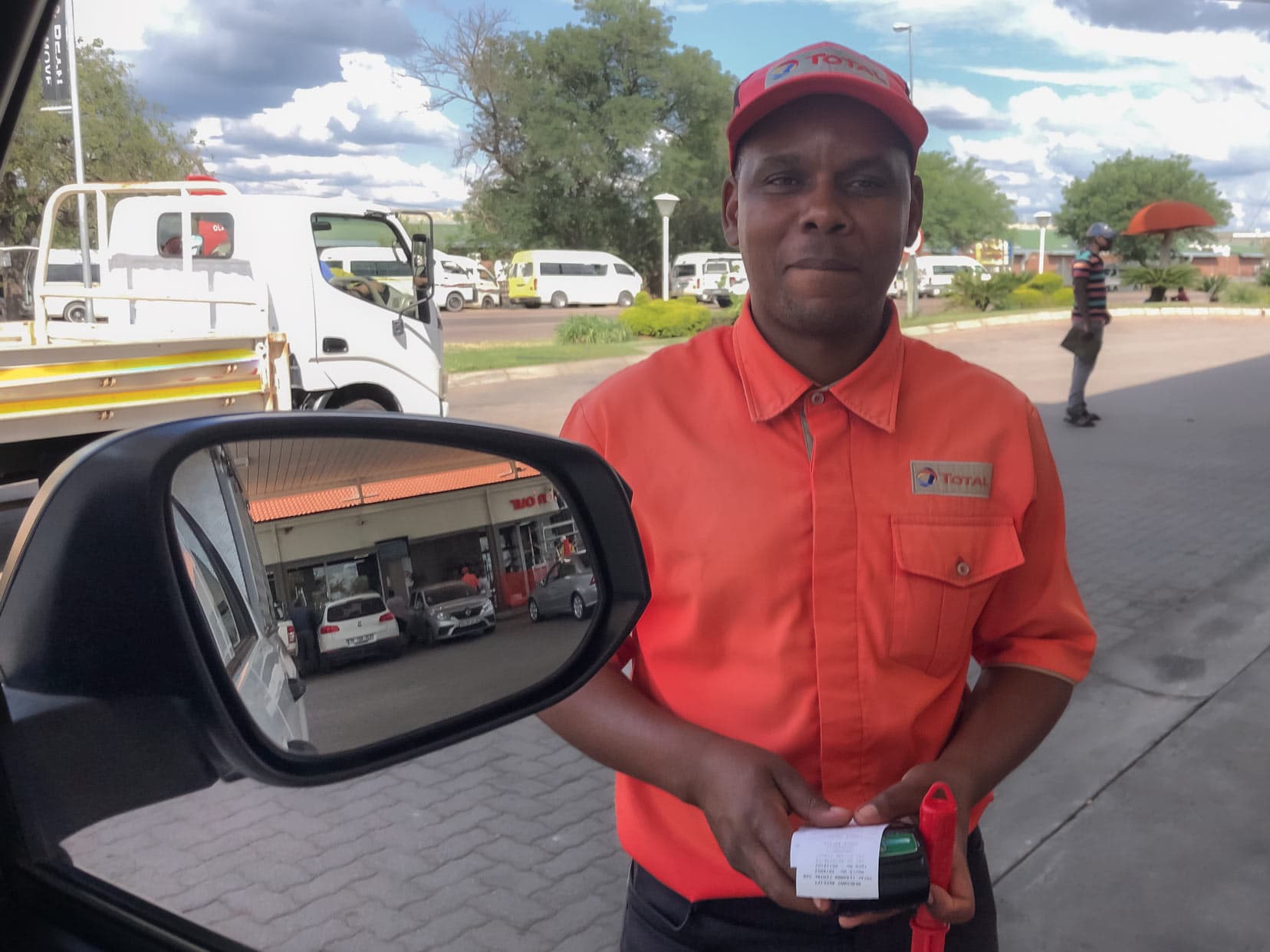
23. You Will Need a 4×4 to self-drive most of Botswana National Parks
Botswana’s parks and reserves are definitely 4×4 territory.
Although not always signed as such at the park/reserve entrances, a 4×4 is definitely needed. Sometimes we were even asked by DWNP (Department of Wildlife and National Park) gate attendants what type of vehicle we were driving.
Some of the best locations are often deep within Botswana’s parks and reserves. You’ll want that 4×4. These machines are built tough, and so they need to be. You’ll be very remote at times, and worrying about vehicle issues should be far from your mind.
If travelling in the rainy season (spring and summer), you can expect flooded tracks to make roads impassable for periods. Expect delays in your travel plans.
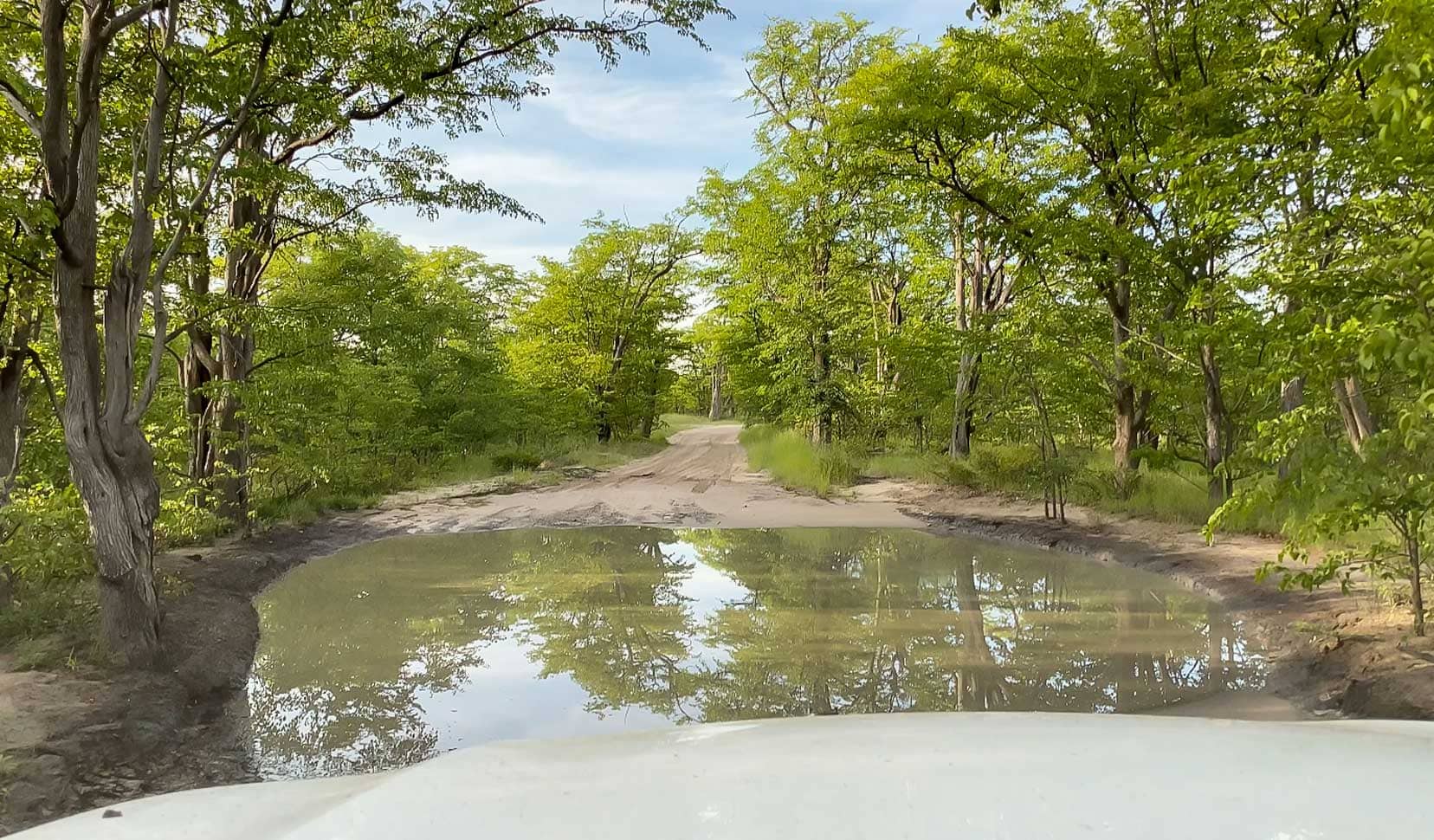
In the dry season, deep washouts are difficult to cross, where the added ground clearance of a 4×4 is welcomed.
Weather and track conditions can be unpredictable at any time of year, so regardless of season, you should travel with suitable vehicle recovery equipment. The minimum is a jack, shovel, tow ropes and tyre traction aids.
24. Keep an Eye out for Wild Animals on and Beside the Tracks
Wildlife crosses the tracks and roads in the parks at will and reacts quickly to your presence, so be wary. Elephants can step out from behind a bush, and frightened impala and springbok can launch themselves into the air to cross tracks.
Give the animals plenty of space to move.
Particularly when elephant bulls are in musth. This is when you have a six-tonne toddler on your hands. The huge amounts of testosterone make them highly unpredictable and prone to unprovoked temper tantrums.
You can spot an elephant in musth by urine (sometimes smelly) dribbling down its back legs and secretions running down the side of its face from the temples.
Female elephants with their calves also need to be given a wide berth as they become very protective and do not take kindly to you being too close.
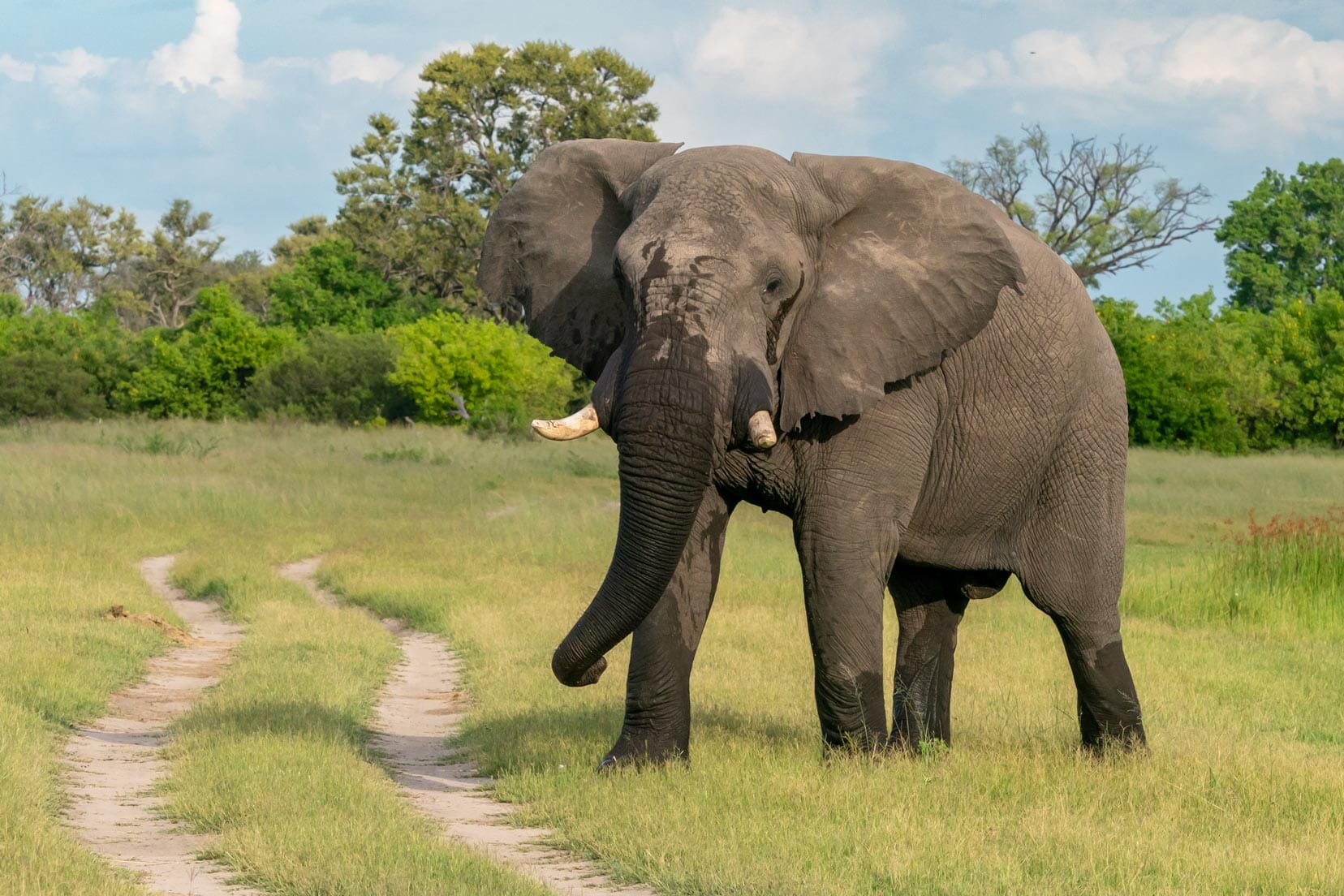
25. Driving Waterlogged Tracks in the Rainy Season
Water will have collected as pools on the tracks during and after the rains. Careful negotiation is required to get through and around these.
Sometimes, you’ll find a bypass in the bush, but often, you’ll need to drive through the pool because the bush beside the road doesn’t allow a detour.
The recurring question always is: How deep is the water?
You won’t know this unless you walk through the pool to check its depth. Otherwise, judging the water depth is just guesswork; the worst-case scenario could be a flooded vehicle.
These water pools can also top up quickly after a downpour. So, in a mere couple of hours, inches can be added to the water level, and a return crossing may be impossible.
And there can be plenty of these water pools to forge through, sometimes spaced one after the other at 50-metre intervals for many kilometres.
Realistically, walking each and every one of them would be impractical. Therefore, another tip is to follow recent tyre tracks.
If there aren’t any recent vehicle tracks in and out of the water pool, then I always aim to drive the edge of the water pool with the driver’s side closest to the edge of the bush.
Vehicles that have previously crossed the pool can leave ruts in the mud from wheel spinning, meaning that the bottom surface is sometimes unpredictable.
It’s also not uncommon to find branches and rocks on the bottom that people have placed there to provide traction under their wheels when bogged. So, if you are walking through, do so carefully.
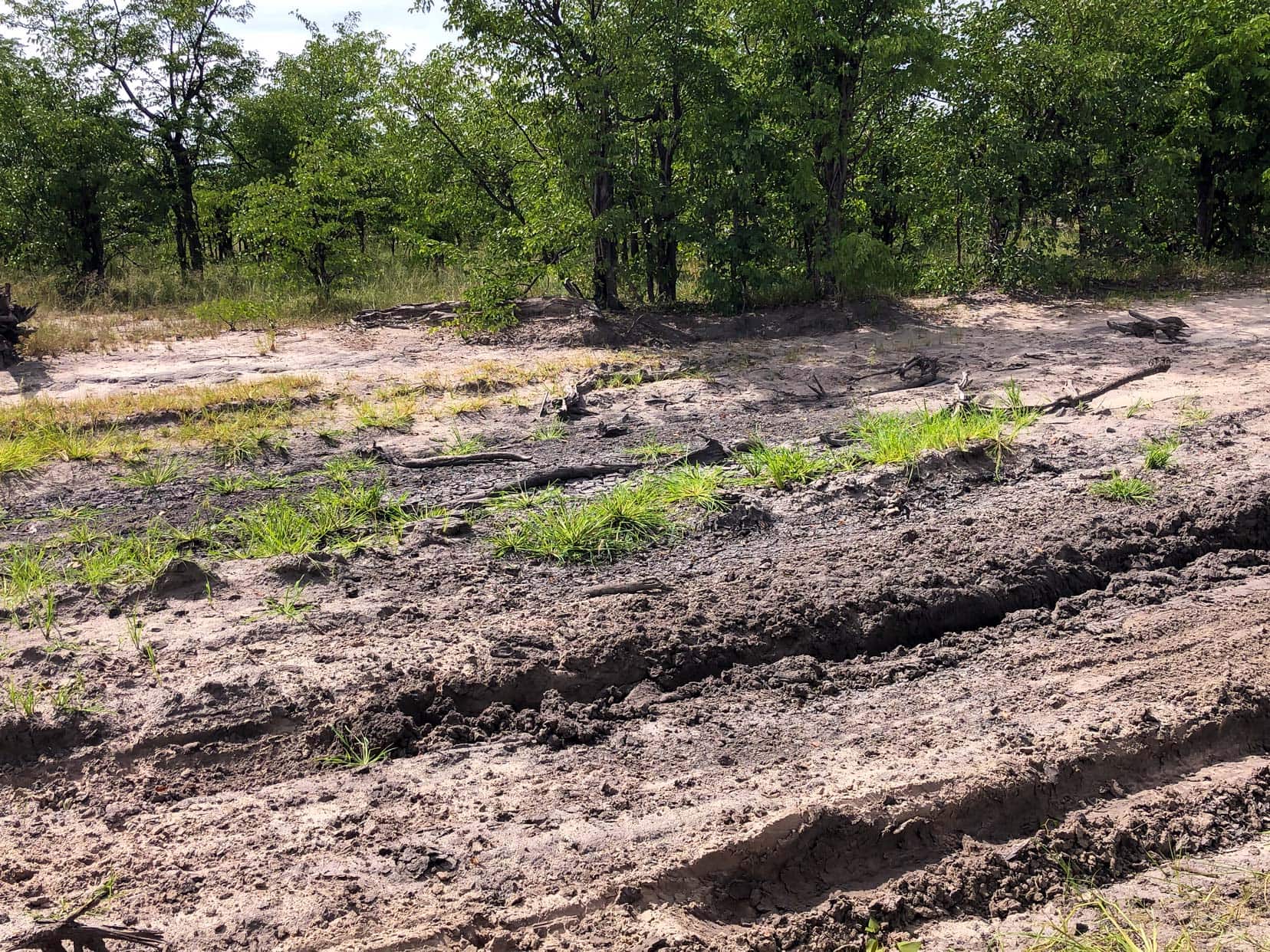
To make checking the water levels even more tricky, crocodiles may lurk in the depths. Stagnant water can also harbour bilharzia, a waterborne minute snail-like creature that burrows into your skin and can cause all sorts of nasty health problems.
But you can avoid some trouble, at least by being forewarned. Ask about the road conditions at the park entrance gates and other game drivers and park visitors.
Make sure to reference a map so you know specifically what areas to avoid.
Finally, always heed the advice of locals. When advised not to drive in a certain area – don’t drive there.
They live there in the area and know the conditions better than most.
26. Speed Limits Within the Parks.
Keep your speed down in the national parks and reserves. Even though a maximum speed is posted (often a maximum of 40km/hr), drive slower to enjoy the experience.
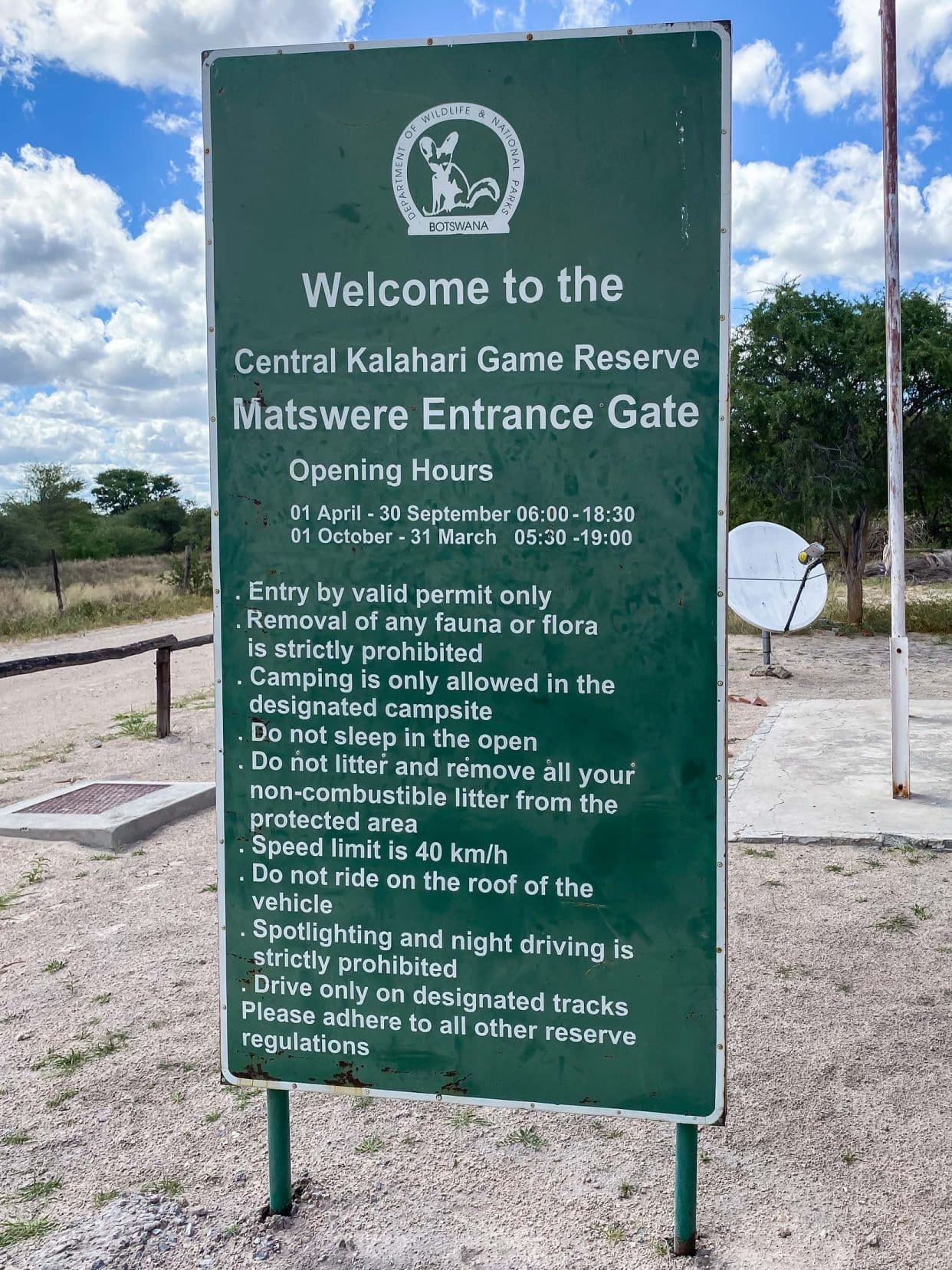
This also makes it much easier to spot any wildlife.
Driving slower also helps to avoid collisions with wildlife that suddenly materialise out of the bush.
27. Breaking Down in the Bush
Whether your vehicle has broken down or becomes bogged – getting stuck in the bush has its own rules.
Always stay with your vehicle. Remember, you’re in the wild. Wandering around looking for help should be avoided.
Be patient, and again, stay with your vehicle. Other game-drive vehicles will find you at some point.
Should you come across a vehicle stopped by the road in the bush, then it’s courtesy to ask if all is okay. If not, then maybe you can help or relay a message to someone at a campsite to have them organise help.
28. Traversing Soft Sand
Soft sand is easier to drive after some rain and early morning when damp and more compacted.
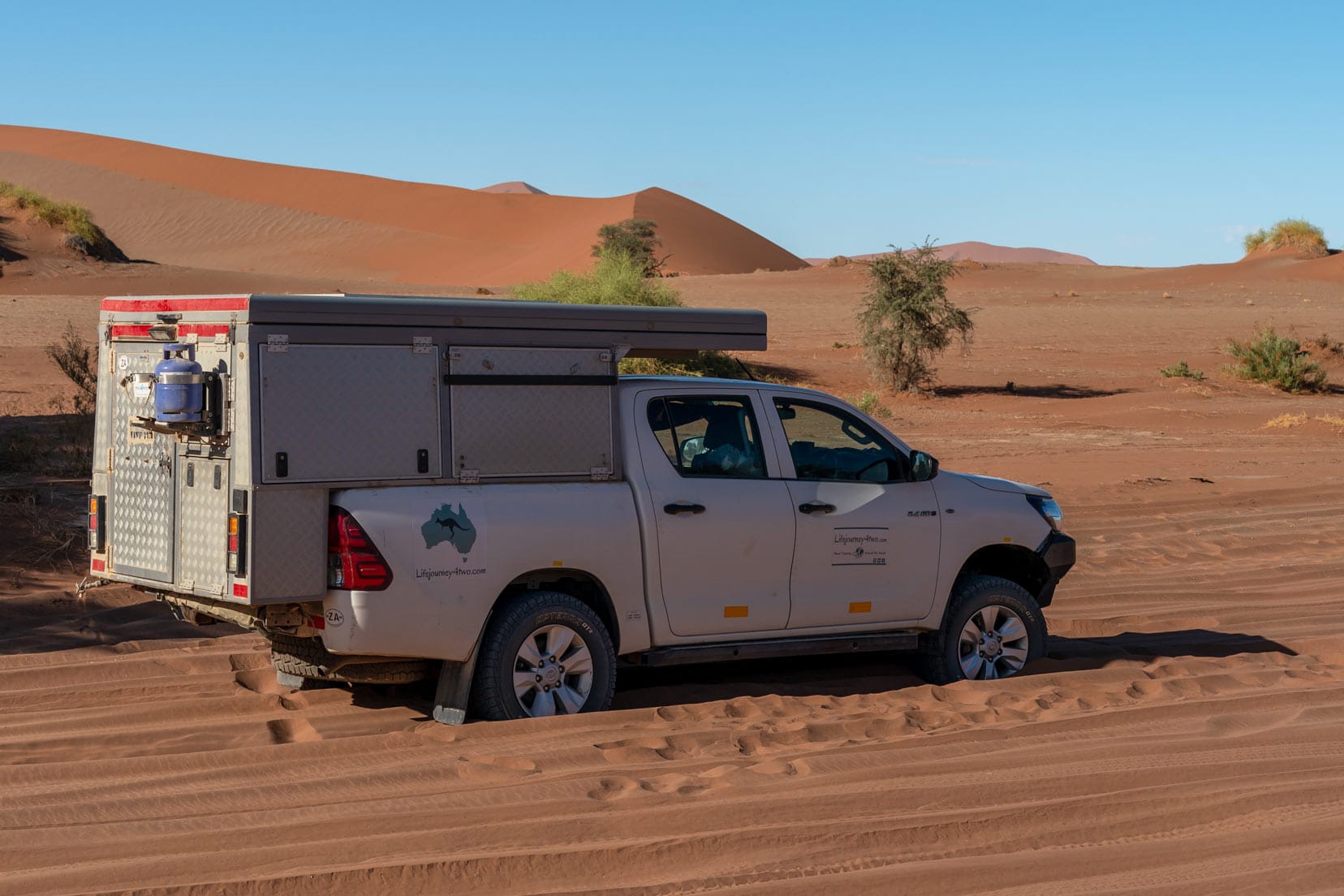
Keeping a lower tyre pressure is key to avoid becoming bogged. Making sure you have traction recovery boards is a good idea.
29. Don’t Drive off Road in Botswana National Parks
It’s definitely a no-no to plough into the bush, making your own tracks as you go. Drive on the tracks provided in the national parks.
Naturally, this won’t apply when nature gets involved, causing a route to be impassable, such as avoiding a flooded road or a fallen tree.
30. Know Your Botswana Visa Stay Allowance
Each country in Southern Africa has its own visa rules and regulations, which can be quite different.
For example, a 3-month visa for South Africa starts the day you arrive and ends three months later, no matter when you actually leave the country. Even if you only used two weeks of those three months, you can’t enter after the three-month date is up (except for a 7-day transit visa).
In Botswana, though, you can use the three months at any time within a year. We were stamped into Botswana for two months after paying the TIP (temporary import fee) for our vehicle and the country entrance fee.
Since we were allowed a maximum three-month stay for the whole year on our Australian passports, we were told that we could re-enter Botswana at a later date in the year to use the remaining 30 days.
Botswana Camping Tips
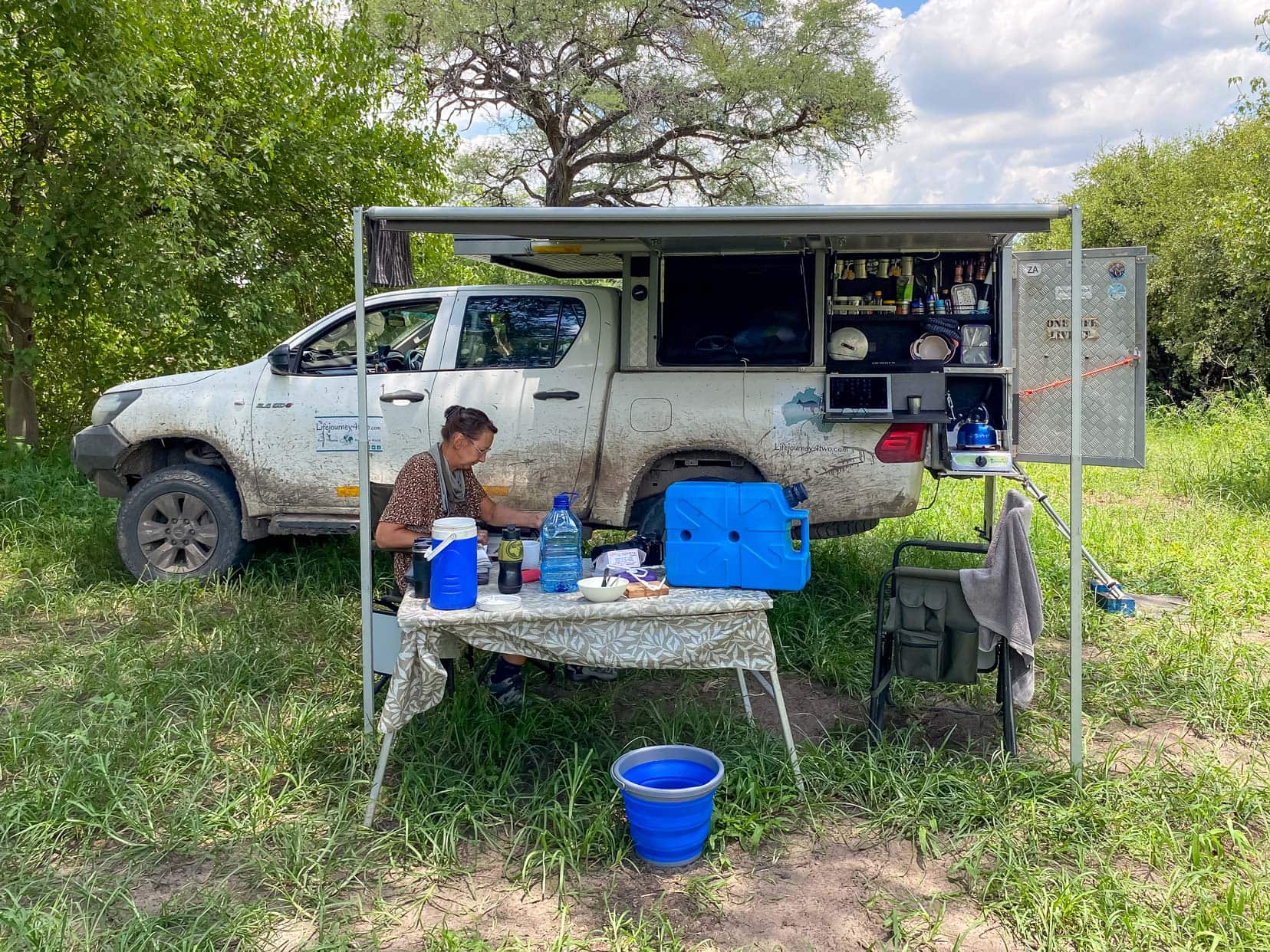
31. Drinking Water in Botswana
The water in most of Botswana’s National Parks isn’t drinkable (it isn’t often signed as such, so you ask at the entrance gate). And when it is drinkable, you can expect either a salty or muddy taste, and that’s after boiling.
We travel with a 20-litre Lifesaver water container or jerrycan that comes with an integrated filter that removes 99.99% of bacteria and viruses and is guaranteed for 5000 litres, plus a secondary charcoal filter that sits in the spout that pretty much takes care of any aftertaste.
It’s worked well for us, and even though this filter is not designed to remove salt from the water, we tested it, and it did a decent job with only a slight salty taste to the water.
While staying in Maun, we also filled our bush camper’s water tank with purified water at Aquarite in both Maun and Kasane. It’s not expensive, and we filled up our 60-litre internal tank plus a 20-litre container for a mere P160.
Also included in the price was a tank flush.
Making a quick comparison, a 5-litre bottle of supermarket water costs roughly P25. Buying 80 litres of bottled water would cost you a total of P400 for 16 of these 5-litre bottles. There are savings to be had, and that helps us budget-conscious travellers.
Aquarite can also take your empty 5-litre containers and have them filled.
While we’re on the topic of filtered water containers, we also used the portable 750ml ‘Water-to-go’ filtered bottles.
Each filter will last 130 litres and remove 99.9999% of viruses and bacteria.
Use our discount code: LJFT15 at checkout for 15% off
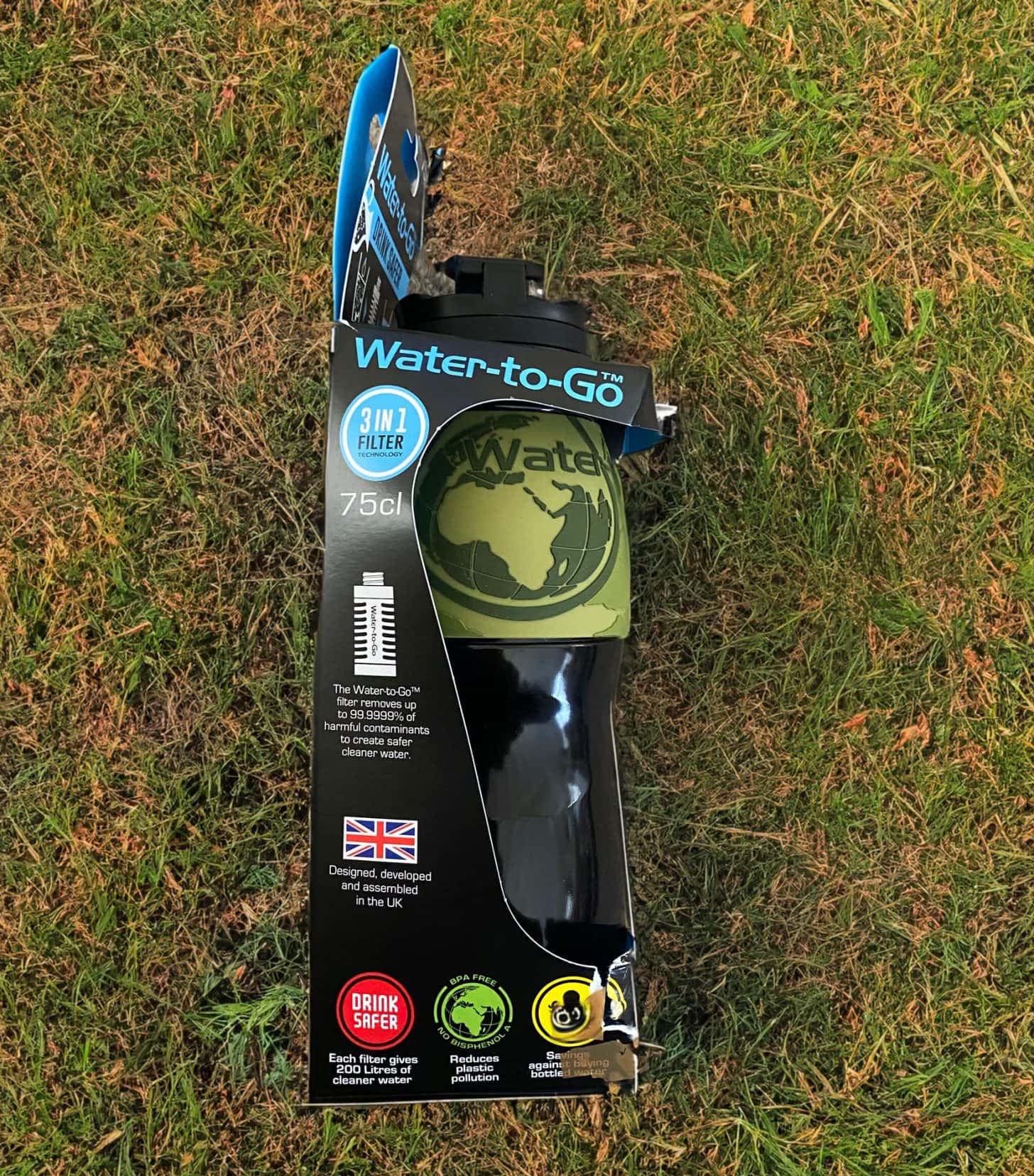
32. Use Insect Screens
If you don’t want thousands of African bugs joining you in your tent or camper, you will need insect and mosquito screens.
We have existing mosquito screens on our tent side panels, but many tiny little bugs could still squeeze through the holes, so we added another layer of fine-grade mesh on top—a secondary layer.
This upgrade was completed by Canvas Zone in Maun. Hendrick Friday, the owner, and his fabulous team measure, make and fit the insect screens to your exact requirements.
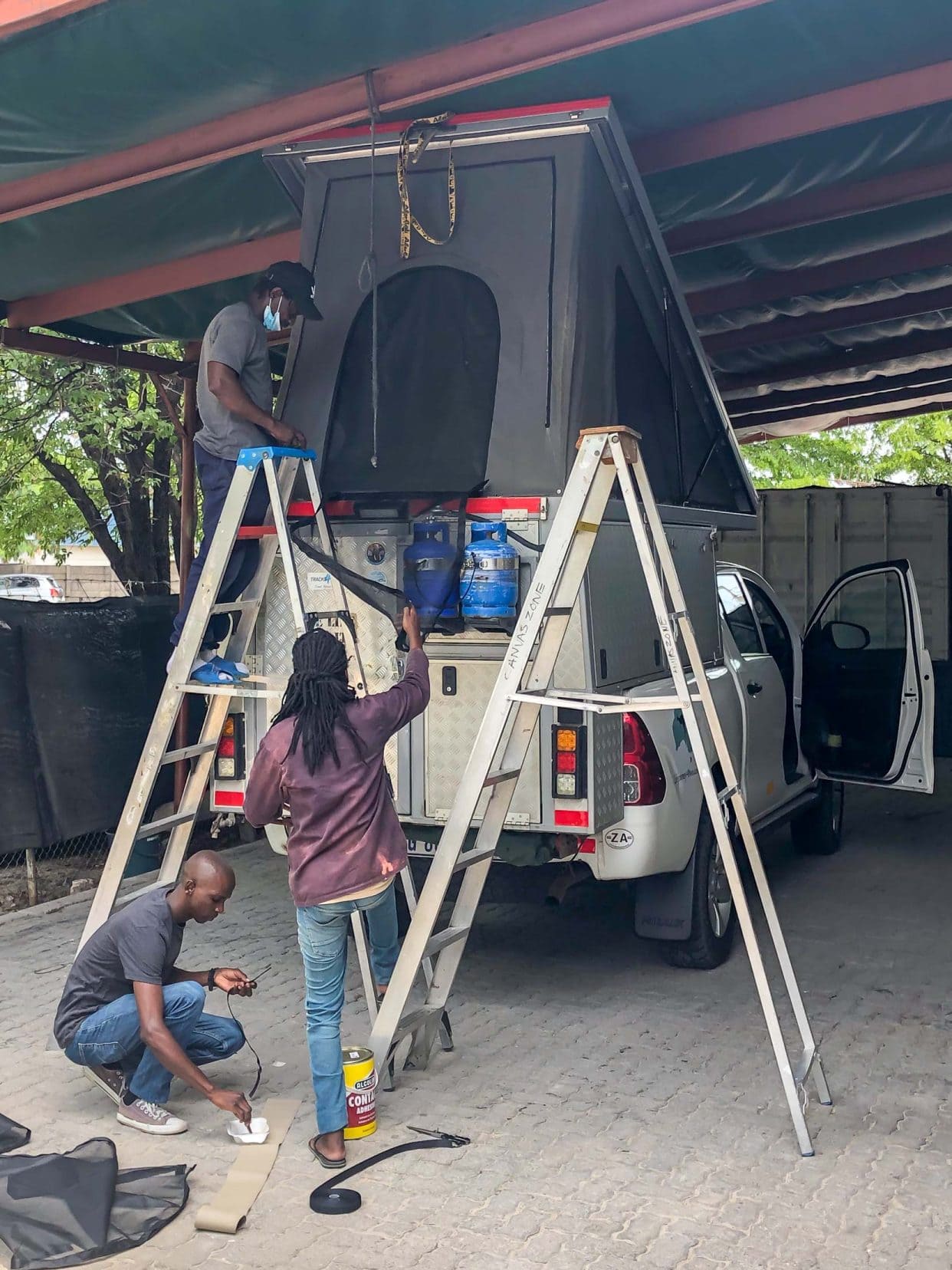
Now, with these fine-grade insect screens, we have a bug-free zone and that makes us very happy campers.
33. Have Your Own Pair of Binoculars
It’s highly recommended, and I would say essential, that each person have their own set of binoculars.
By tuning in your own specific settings that suit your eyes, the binoculars are ready to go at a moment’s notice … and sometimes you only have a moment to see something before it vanishes into the bush or flies off out of sight.
Shelley uses a pair of Avalon binoculars, which have stood the test of time. I have the Opticron Adventurer II WP (10×42), which is one year old and a major disappointment; the workmanship is obviously poor, with a lens eye cup that fell off (I’ve glued it back in) and the adjustable eye-cups not being able to retain a fixed position (I’m using rubber bands as a spacer).
And just for the record, I treat my gear like my wife, with cotton gloves. Here is a photo of the culprit.
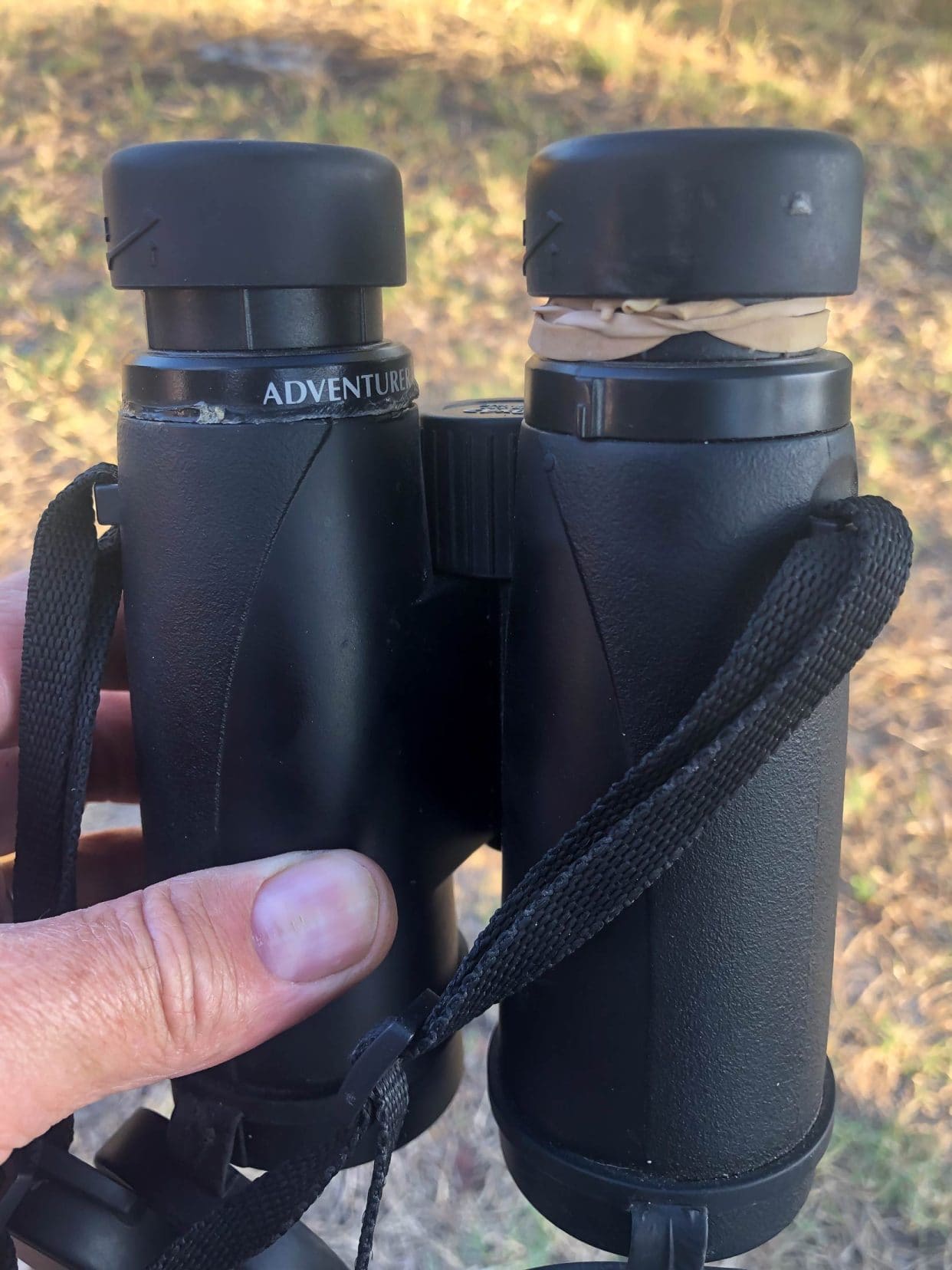
34. Watch out for the Cheeky Camp Thieves: Baboons, Vervet Monkeys and Hyenas
Be aware of leaving food, shoes, and smallish items out in the open that can be taken by baboons and hyenas.
We had some lettuce grabbed off our table by vervet monkeys while in Moremi South Camp, and at another camp, we saw a baboon running through camp with a whole loaf of bread.
One night, I left my shoes on the ground, and the next morning, I was reduced to one. The culprit, a hyena, left a nice set of footprints leading away from camp.
35. Night-time Toilet Trips
Be mindful that animals, particularly predators, are on the move at night. You don’t want to hop out for a wee only to come face to face with a lion …, and I doubt it’ll be too happy about it either.
So, what do you do?
We keep a capped, pee-tight container in the bush camper, which we use during the night.
Shelley uses a ‘Freshette’, which is a super-portable female urinary device that makes it much easier to pee in a confined space. She can wee while standing, and it’s one of her must-have items while we travel.
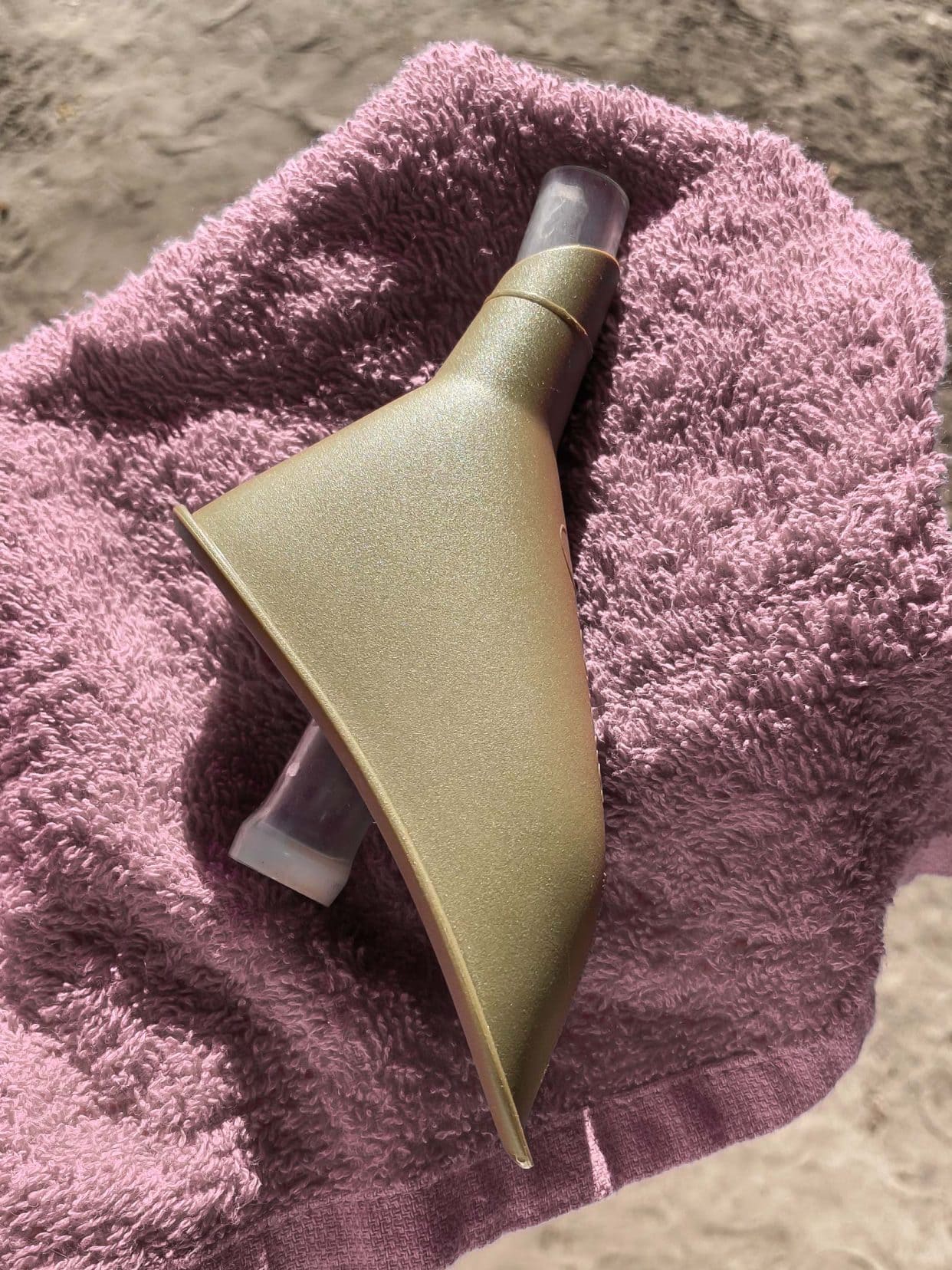
By doing this, we completely remove the risk of an undesirable meet-up with any of the 4-footed creatures in the open at night.
I mean, depending on the park location, you could expect lions, leopards, elephants, hippos, snakes or scorpions to lurk in the shadows.
Still fancy using that outside toilet?
36. Campsite Fires
We were told by the locals that having a campsite fire would help keep the animals at a distance. There were firepit areas in all the campsites we visited – even the really remote ones.
Braais are popular in Africa (cooking on the wood coals, like a BBQ), so you’ll find many locals or campsites selling firewood.
37. Botswana National Park Campsites
We found that generally, the National Park campsites were quite run-down.
During our summer visit, although many campsites were touted as having solar hot water, only one of the many campsites we stayed at lived up to this promise consistently: Savuti Campsite in Chobe National Park.
At one campsite, Camp Ihaha in Chobe, I even found a couple of dead rats in the shower basin.
38. Tinkers Guide
The Tinkers National Park Guide is sold at some park entrances.
This magazine is park-specific and includes useful information on what wildlife inhabits the park, the park history, driving routes, and other helpful information for the visitor.
We bought the different Tinkers magazines at Chobe, Moremi and Makgadikgadi. The price was a standard 200 Pula. However, at Moremi, we had to dig deep for the stated 350 Pula. We questioned this markup but ended up paying in full, and the book was really quite useful.
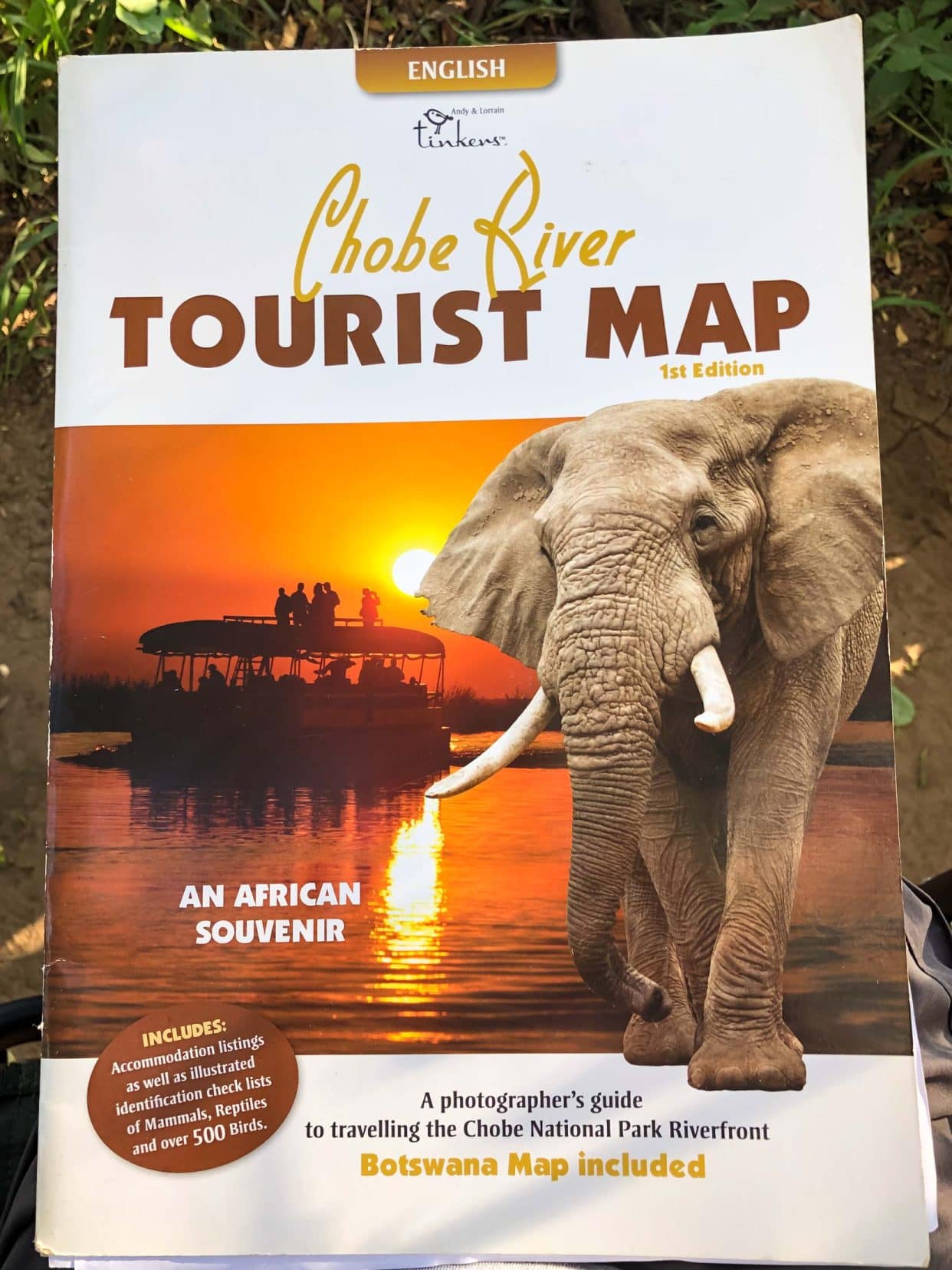
39. Network Signal in the National Parks
Don’t expect a network signal in the National Parks. However, at some of the parks, Wi-Fi can be accessed for a few minutes for free at the entrance.
Sometimes, it is openly signed that WIFI is available, but this isn’t always the case. You can just ask. It’s not unusual that you are asked to cap your online access to 5 minutes.
40. Wildlife Sightings
National Parks often include a sightings book at the gate and a sightings board.
Here, you can see what animals have been sighted and the location.
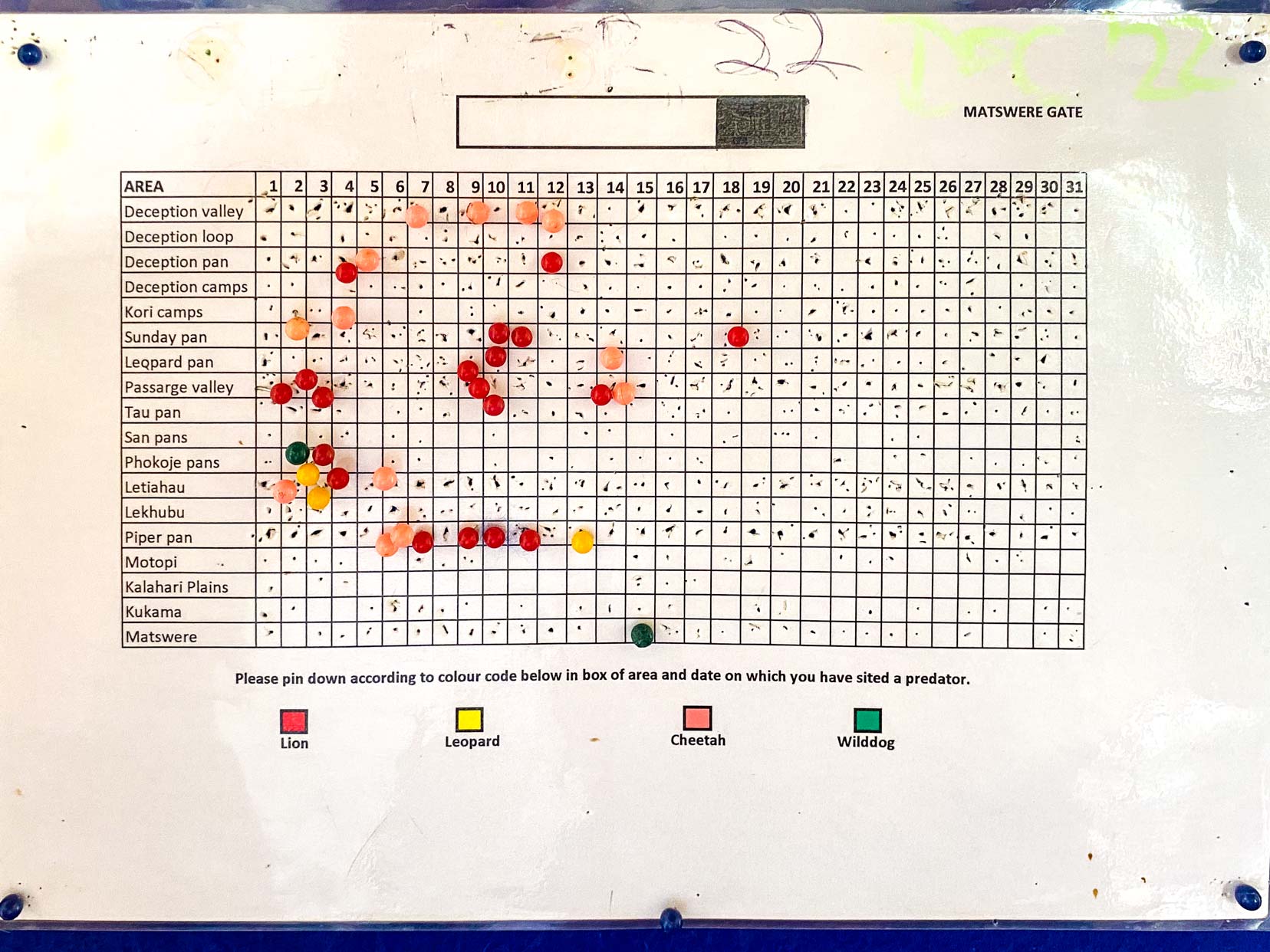
Of course, as you are well aware, I’m sure there’s no guarantee that wildlife will be when it was last spotted, but at least you know what’s around.
41. Buying Meat in Botswana
The meat sold in Botswana is hormone-free, and it’s relatively cheap. Meat lovers will be at home here.
There are plenty of butcheries, and also the supermarkets, Spar, Choppies, and Pick n Pay all sell meat.
42. Seasons and Weather in Botswana
The summer months in Botswana bring the rainy season, and the winter months, the dry season.
Summer in Botswana
In summer, temperatures range around 30 – 35 degrees but can reach up to 40 Degrees Centigrade.
We travelled to the Central Kalahari Game Reserve (CKGR) in the summer and underestimated how much water we would need. It was very hot. Every day was between 38 to 40 degrees C, and we drank 5 litres of water daily.
Something to bear in mind when you are stocking up on water.
In summer, Botswana is lush and green, and it is the time when many of the wild animals give birth. It is a time of new beginnings.
Visiting in the summer meant we saw lots of migratory birds that aren’t around in the winter, such as the stunning carmine bee-eater entourage that accompanied across the fields of Savuti in Chobe National Park.
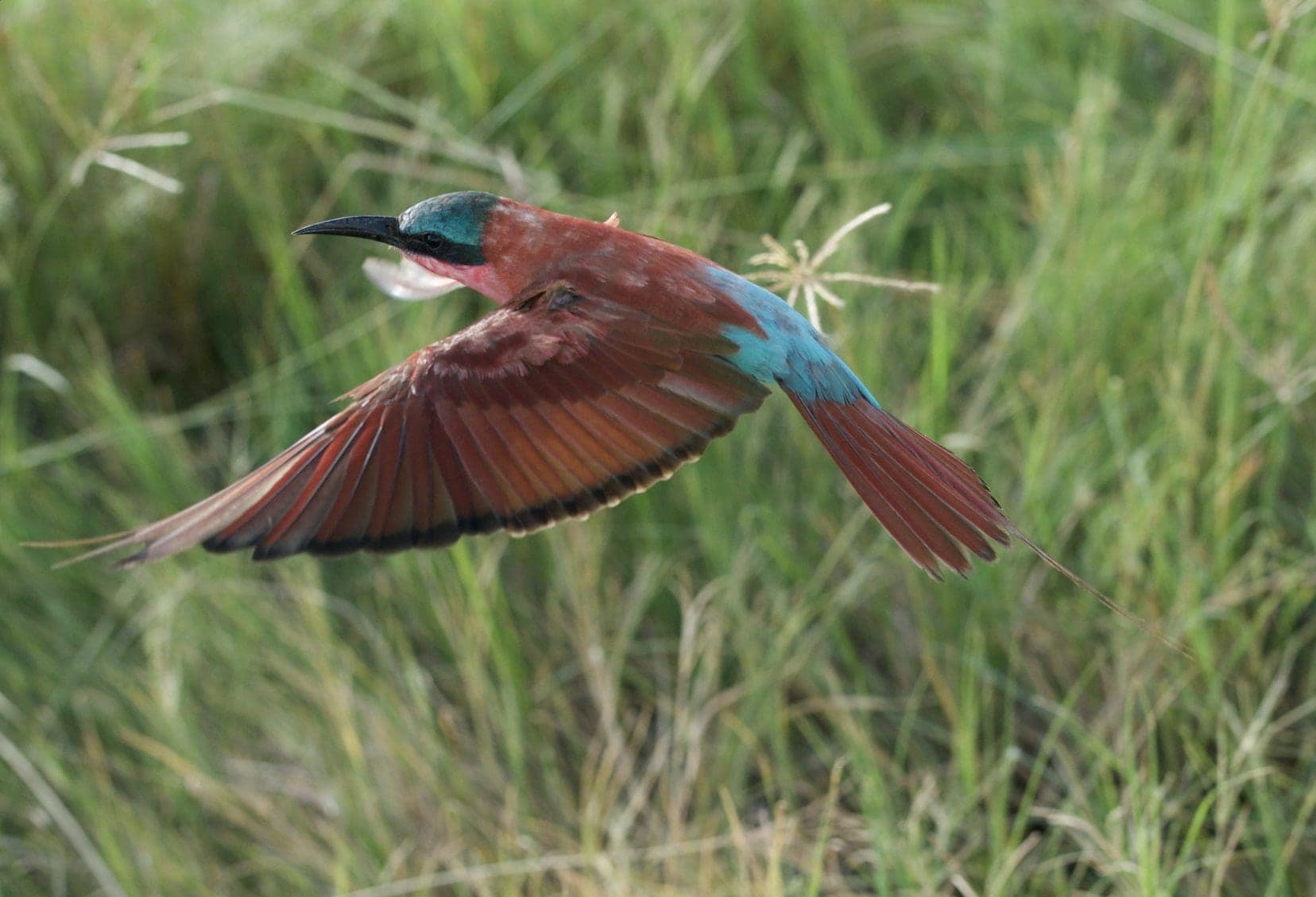
Summer also brings with it impressive afternoon thunderstorms. The sky turns black, and lightning streaks encircle you. It’s like being in a 360-degree cinema, and you’re not sure which direction to look next.
There is no doubt about it: travelling through Botswana in the summer is hot. But there are benefits to overlanding in the summer:
- It is in the off-peak season, so it’s easier to book campsites or even just turn up (in the peak season, some camps get booked out up to a year ahead).
- Many campsites and accommodation rates are cheaper.
- Migratory birds arrive in summer and leave in winter.
- The Botswana bush is lush and green.
Our ‘cooling towels’ were invaluable during these hot nights and the day. Particularly between two and four o’clock when the temperatures reached their peak.
Winter in Botswana
In winter, daytime temperatures are between 20 – 30 degrees but expect minimum single-figure temperatures at night. In the desert areas, temperatures can drop below freezing at night.
The peak season for overlanding in Botswana is in the winter months for several reasons:
- There is less vegetation, so it is easier to spot wildlife.
- The roads in the national parks are less likely to be flooded.
- The daytime temperatures are more comfortable.
43. National Park Fees
The various Botswana National Park fees can be paid either at the gate or prepaid at a DWNP (Department of Wildlife and National Parks) office.
Most of the parks only accept cash, so you need to either keep a large amount of Pula on you or pay the DWNP before entering the park at one of their offices in Gaborone, Maun, Kasane or Ghanzi.
We paid our bulk fees at DWNP in Maun.
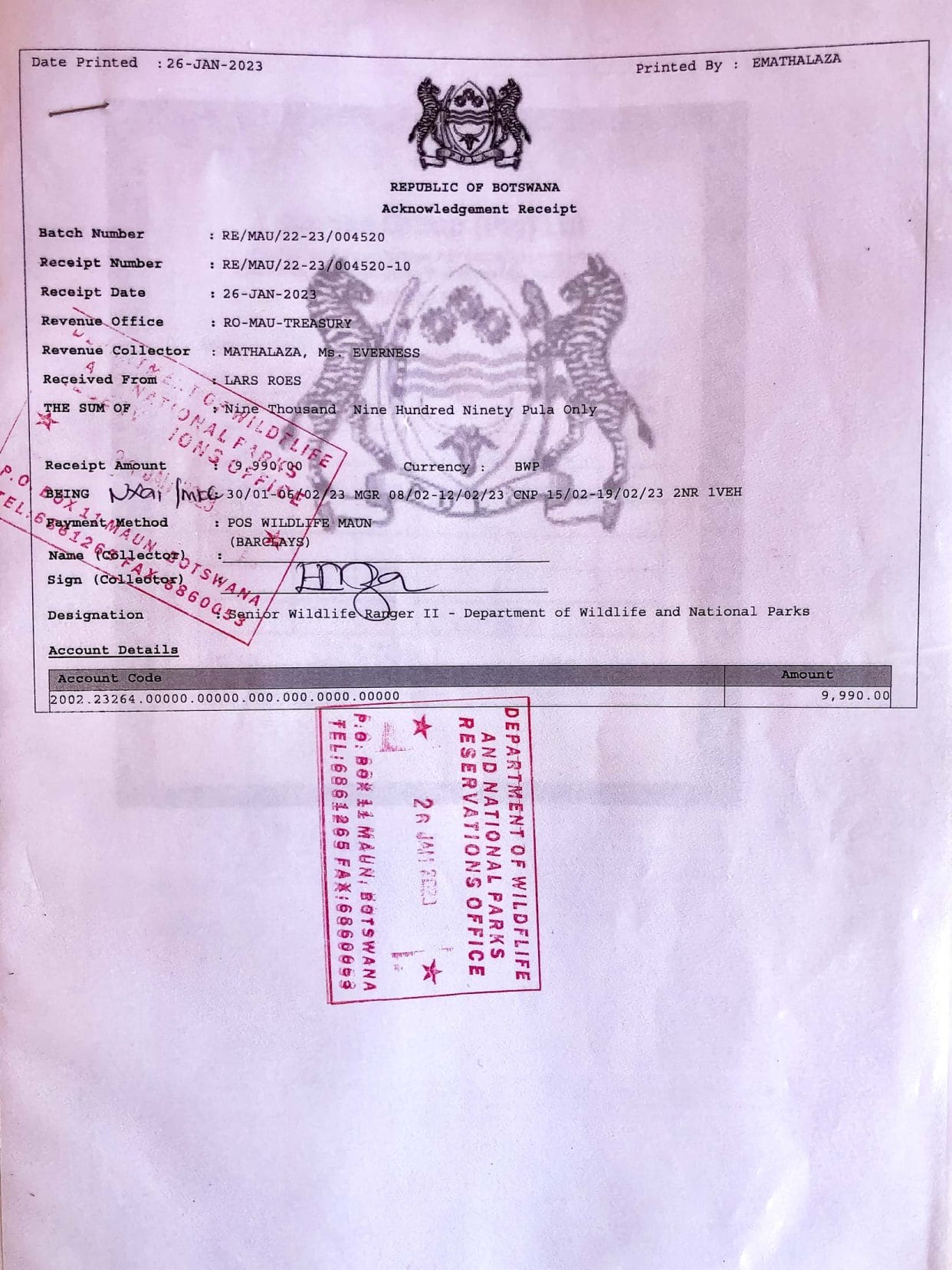
44. Emergency Phone
Letting someone know your plans for entering and leaving a park is a good idea, especially if you are travelling during the rainy season, when you may become bogged down and delayed.
If you are travelling remotely, seriously think about purchasing or hiring a satellite communicator or phone.
We always carry our Garmin InReach Mini with us. It’s reassuring to know that it’s only a button press away if we need assistance in an emergency.
45. Fences
The Botswana National Park and Reserve campsites are all unfenced. This means that you should keep an eye out for wildlife, as they can wander through camp at any given time.
Several elephants passed through our camp at Nxai Pan, Makgadikgadi, Moremi and Khwai Concession.
And in the Kgalaghadi, we had lions come through camp … twice.

46. Camp Hopping
Our recommendation is to spend a minimum of two nights at each camp. This way, you aren’t bouncing from campsite to campsite too quickly, and you get time to experience a location.
Wildlife sightings aren’t guaranteed. The longer you spend at a place, the better your chances of sightings.
47. Have a Flexible Overland Botswana Itinerary
It’s great to have a schedule. However, even the best planning needs to be flexible.
A good example was our planned two-night stay at Baines Baobabs in Botswana. To reach these massive trees, you must drive across a large salt pan.
The night before we were due to camp there, there was a heavy downpour, which meant that the pan was drenched with water. We’d heard horror stories of vehicles being seriously bogged on wet salt pans.
We had driven part of the way across the pan surface, hoping to beat the coming storm; however, the storm struck when we were partway across. Rain was falling in bucket loads.
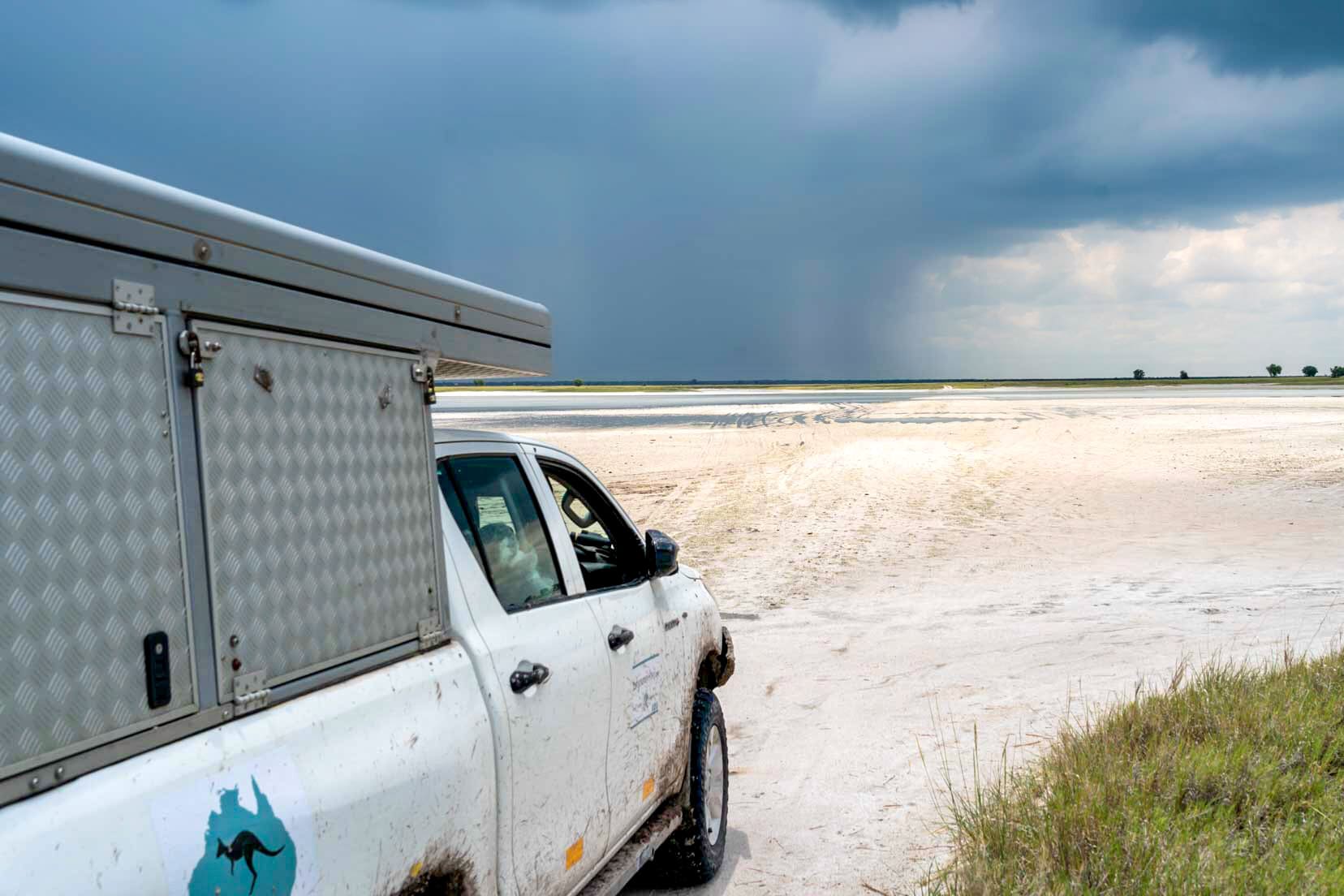
We quickly abandoned going any further and traced our tyre tracks back out.
That was enough for us.
Our two-night stay was abandoned, so we made a new plan and returned to Nxai Pan for a few more nights.
48. Daytime wildlife sightings
Generally, most wildlife find shade during the hottest times of the day.
Therefore, early morning and late evening are the best times of day for sightings.
Also, for photography, the light is softer at these times, with a lot more vibrant colour.
Botswana Overlanding Tips for Health
49. Visit a Travel Doctor
It’s wise to visit a travel doctor if you expect to visit remote locations where getting medication or treatment will be difficult.
Ensure you are current on routine vaccines such as measles, mumps, rubella, diphtheria, tetanus, and pertussis. Additionally, consider getting vaccinations for diseases like hepatitis A and B, typhoid, and rabies.
The South African doctor we saw gave us prescriptions for anti-malarial medication and anti-biotics as well as recommended anti-nausea and diarrhoea meds plus an antibiotic cream for any infected bites or scratches.
50. Be Prepared for Mosquitoes
Our final overlanding Botswana tip concerns mosquitoes, our bugbears when travelling… excuse the pun.
Not all mosquitoes carry malaria, but they love a good bite, leaving you with irritating, itchy, red lumps.
While we were in the Kgalaghadi Transfrontier Park, we met an international research team investigating whether malaria-carrying mosquitoes were present.
Interestingly, we were told that the visual indicator for a female mosquito carrying malaria is that it will sit with its bum up.
Most of the time, you don’t see these little critters biting you, so this isn’t going to be much help in determining whether or not you might be infected.
So, how can you combat mosquito bites?
- Firstly, wear light-coloured clothing with long sleeves and long pants in the early evening /night/ early morning.
- Use a trusted mosquito spray (on yourself, the tent and your clothes. We use two brands of mosquito repellent that can be bought at most of the supermarkets in Botswana: Peaceful Sleep and Tabard
- Use mosquito nets and screens.
- We also took malaria prophylaxis on the recommendation of our doctor – doxycycline.
Overlanding Botswana Tips FAQS
Can you self-drive in Botswana?
Absolutely. This is how many overlanders choose to travel to see the best of Botswana’s national parks and reserves. You don’t need a high level of 4×4 experience, especially if driving outside the rainy season, just some forward planning.
Is it safe to drive in Botswana?
Yes, it is safe to drive in Botswana. The main sealed roads are wide and in good condition.
How do I plan an overlanding Botswana trip?
Our approach was to use the Tracks4Africa maps and books in tandem with many Google searches and then bounce this information off the overlanding Facebook forums to get their feedback and any recommendations.
Do I need a 4×4 to overland Botswana?
It is highly recommended that you drive a 4×4 vehicle; otherwise, permission to access Botswana’s national parks and reserves will not be granted. A 4×4 can engage all four wheels when driving marginal track conditions and is manufactured specifically to handle rough off-road conditions.
What do I need to pack for an overland Botswana trip?
For a Summer trip, wear breathable clothes (both short and long to combat the sun and mosquitoes), a hat, sensible footwear, sunscreen, and mosquito repellent. In winter, pack warm clothes as the minimum temperatures drop into single figures. Sturdy footwear is recommended for any Botswana safari.
What is Botswana known for?
Botswana is best known for its fabulous unfenced wildlife, which can be found throughout the country. You may be familiar with names like the Okavango Delta, Moremi, Chobe, and the Kalahari Desert.
Overlanding Botswana Tips– That’s a Wrap
I hope you’ve found this article on overlanding Botswana tips helpful and that it’s given you better insight into planning your Botswana safari or your overland Botswana tour.
Overall, Botswana is a fantastic destination for wildlife enthusiasts and those seeking an adventurous safari experience. With proper planning and research, you can have an unforgettable trip to this beautiful country.
These tips should set you on the right path for an amazing Botswana overland trip.
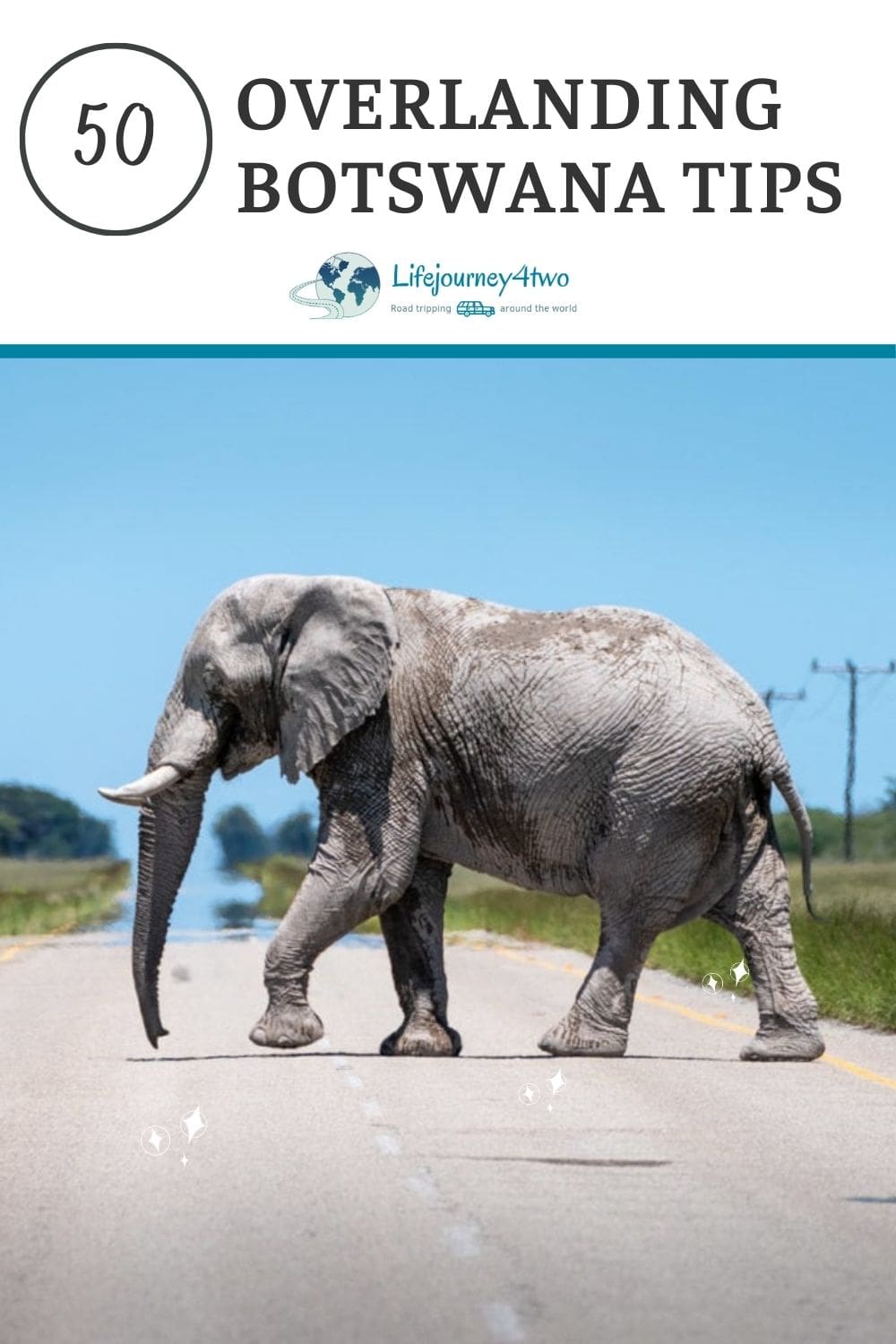
Planning Your Travels?
These are the travel resources we recommend and use when planning our trips.
- 🚘 Car Hire: We use DiscoverCars.com
- Motorhome/Campervan Rental: We highly recommend the Motorhome Republic
- 🪪 Order your International Driver’s Licence online here
- 🛏 Book Accommodation: We use Booking.com to find accommodation that suits our budget
- 🐶 Pet Sitting/Pet Sitters: Check Out TrustedHousesitters here (Use our Discount code: LIFEJOURNEY25 for 25% off. )
- Activities and Experiences: Get Your Guide and Viator
- Travel Insurance: Safetywing or World Nomads
- 🥾 Travel Gear and Accessories: Check out our top picks here — Lifejourney4two page on Amazon
For a more thorough list, visit our Travel Resources page here.

